-
Point Lobos: Crown Jewel of State Parks
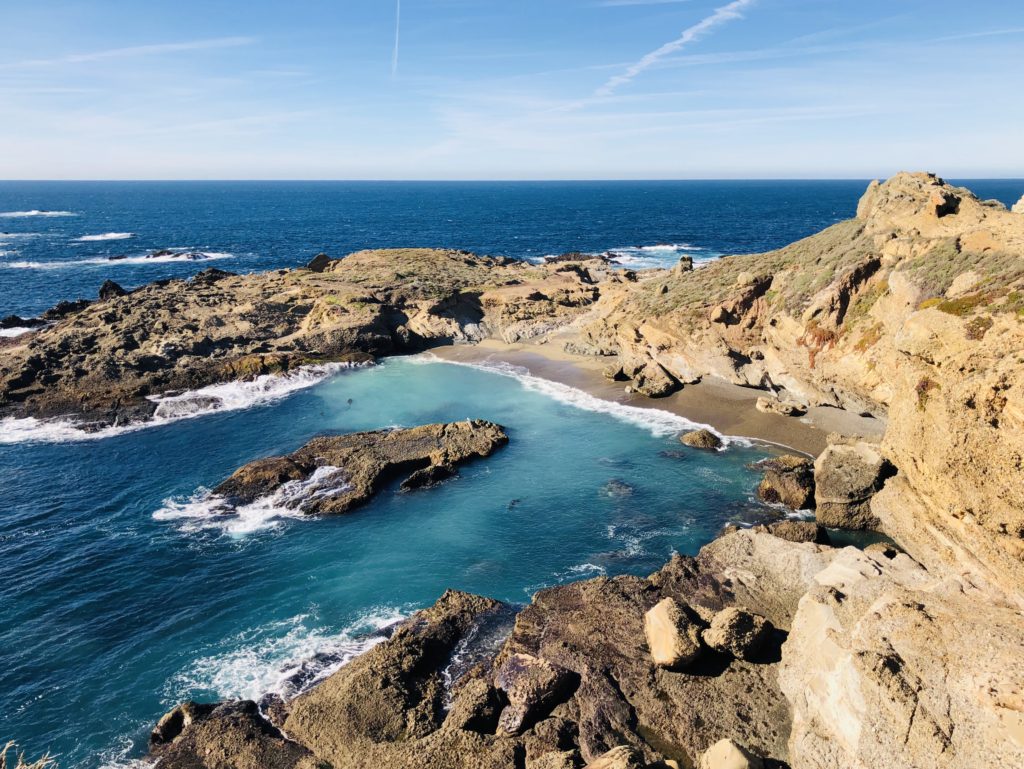 With turquoise waves crashing onto pristine sandy beaches, sunlight cascading through towering cypress trees, and beautiful flora and fauna surrounding you, it’s hard not to fall in love with Point Lobos. Located just south of Carmel-by-the-Sea, Point Lobos is named for a rock formation called Punta de los Lobos Marinos, or Point of the Sea Wolves. It is considered the “crown jewel” of the state park system. Whenever I have visitors from out of town, this is one of the first places I take them.
With turquoise waves crashing onto pristine sandy beaches, sunlight cascading through towering cypress trees, and beautiful flora and fauna surrounding you, it’s hard not to fall in love with Point Lobos. Located just south of Carmel-by-the-Sea, Point Lobos is named for a rock formation called Punta de los Lobos Marinos, or Point of the Sea Wolves. It is considered the “crown jewel” of the state park system. Whenever I have visitors from out of town, this is one of the first places I take them.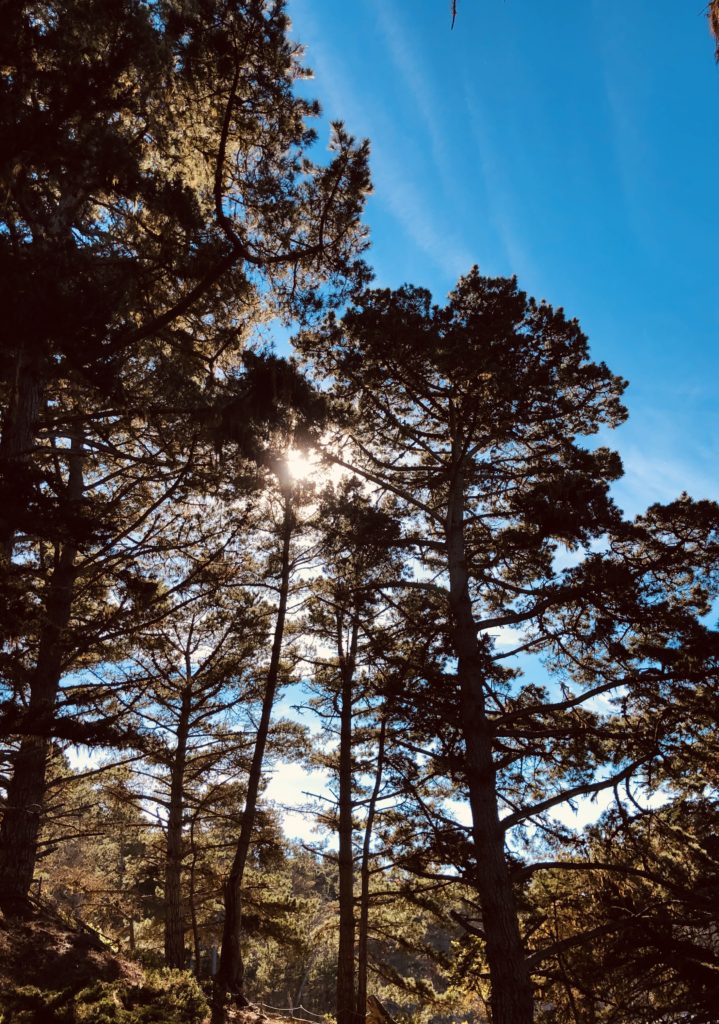
Point Lobos is one of only two places where the rare Monterey Cypress are found. One of the first things you may notice when you enter Point Lobos is the wonderful olfactory experience. If you could bottle this fresh, piney, ocean scent, I’m sure it would outsell Tom Ford. If you have sinus problems or a headache I think you should come here and just inhale the clean, sweet air. I swear it is that powerful. I love the scent, the scenery, and the flexibility of the trails here. It doesn’t matter if you are wheelchair bound or have scaled Half Dome at Yosemite, there are trails here for everyone.
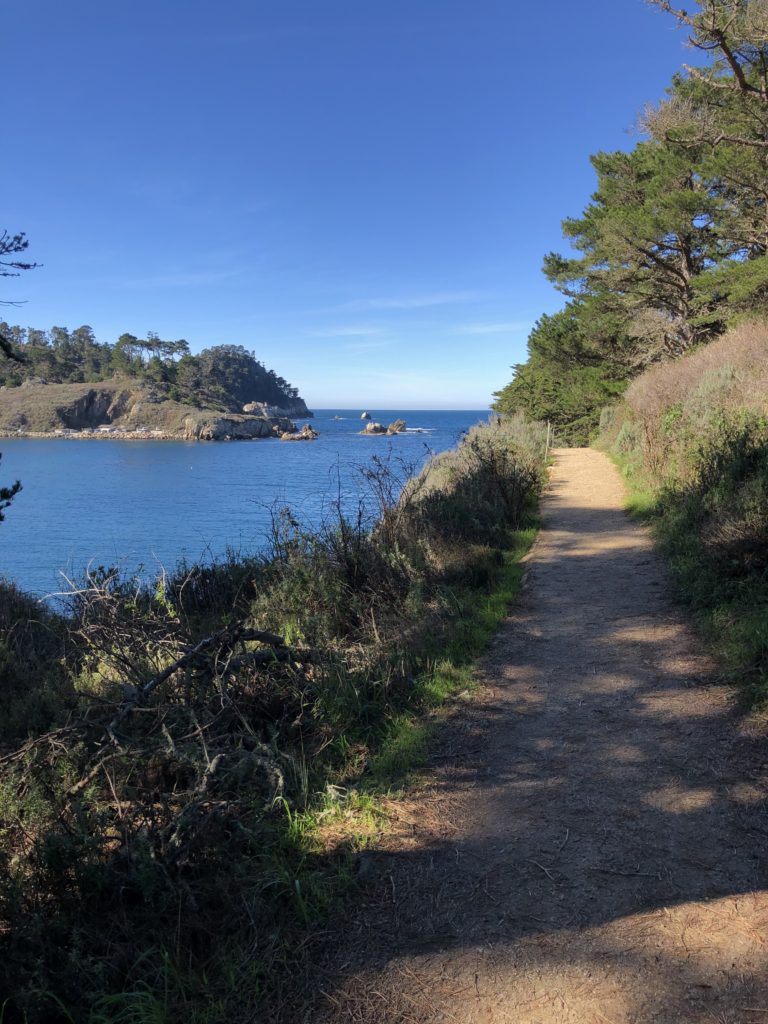
Multiple movies have been filmed here, including Treasure Island, Lassie Come Home, The Sandpiper, The Graduate, and Turner and Hooch.
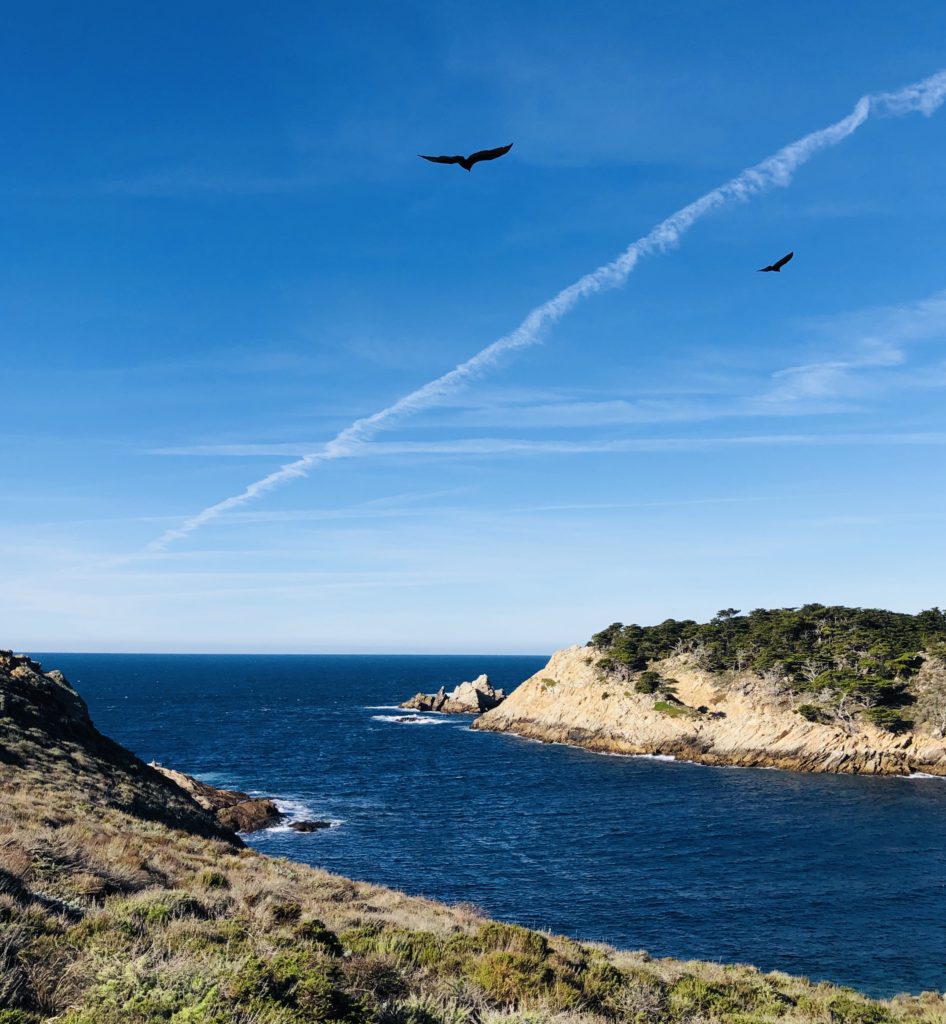
You may see Gray, Humpback & Blue Whales in the area as well as other wildlife. 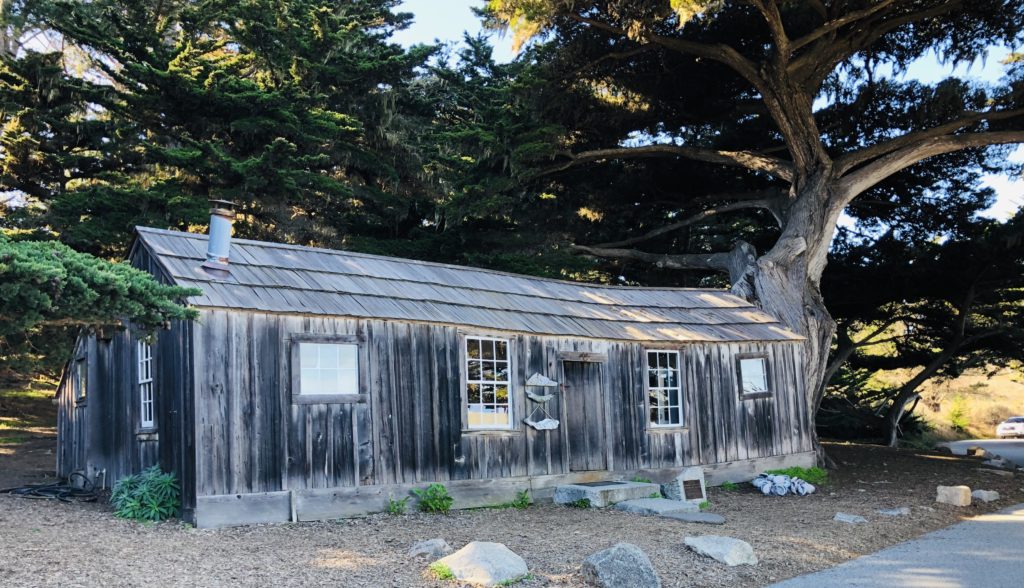
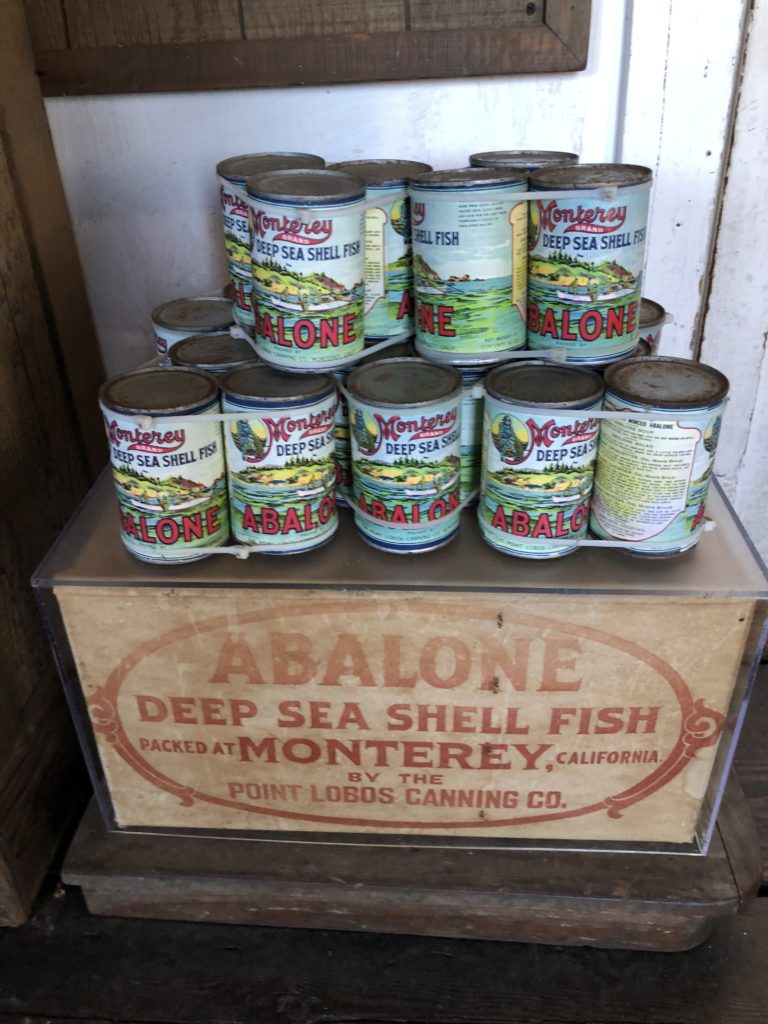
History buffs may enjoy the Whaler’s Cabin and museum filled with interesting artifacts relating to the history of the area. Whales were widely hunted here (I know, it makes me sad too) for their oil. Apparently, whale oil was quite the commodity until the early 1880s. It was used primarily for lamp fuel until it was replaced by cheaper petroleum products. Abalone was another industry at Point Lobos.
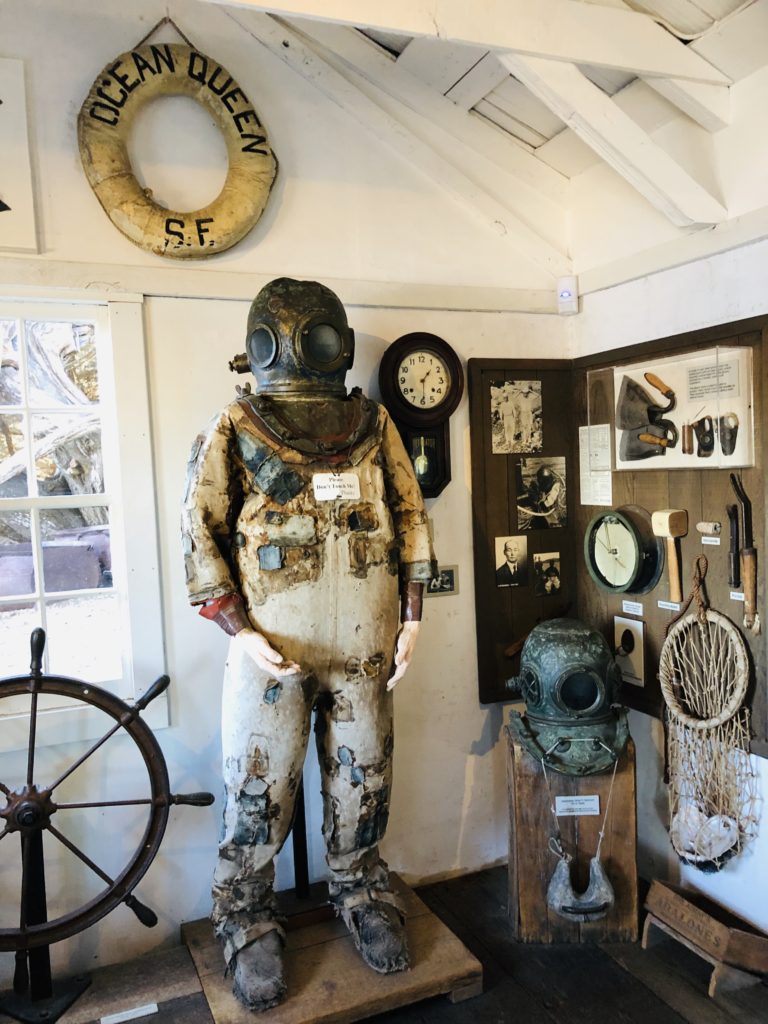
Over time, Point Lobos evolved from the whale and abalone industry to an area to simply enjoy nature, thanks to the efforts of Alexander MacMillan Allan, who began purchasing the land in 1898 in an attempt to preserve it, and the State Parks Commission who in turn purchased it from him in 1933. Thanks to the forethought and dedication of Mr. Allan, we are able to enjoy this pristine beauty today.
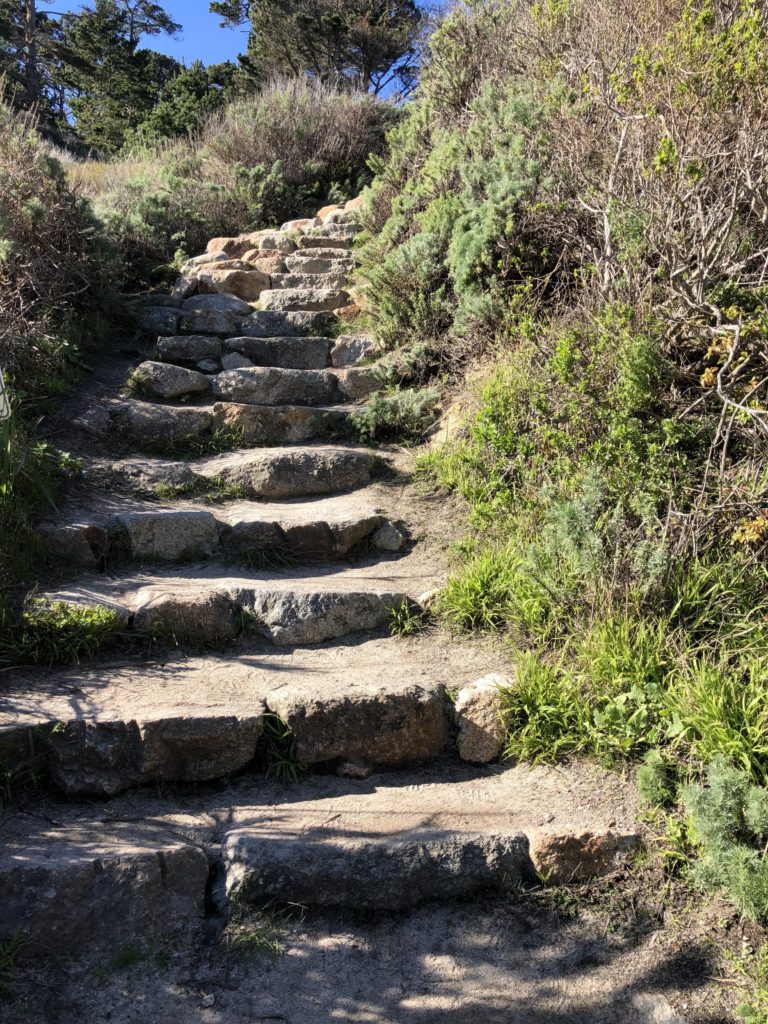
My favorite trail here is the North Shore Trail which leads you along the ocean’s edge with breathtaking views of the forest and sea. This time of year, harbor seals are giving birth and you may see areas cordoned off to protect the mothers and their pups. Be aware that on this particular trail you may have to squeeze by or climb over boulders and/or navigate large tree roots and rocky, uneven terrain. The trail ends in a large meadow which leads to a parking lot. You can continue to follow the trail on the right side of the parking lot to view exquisite overlooks of the beach.
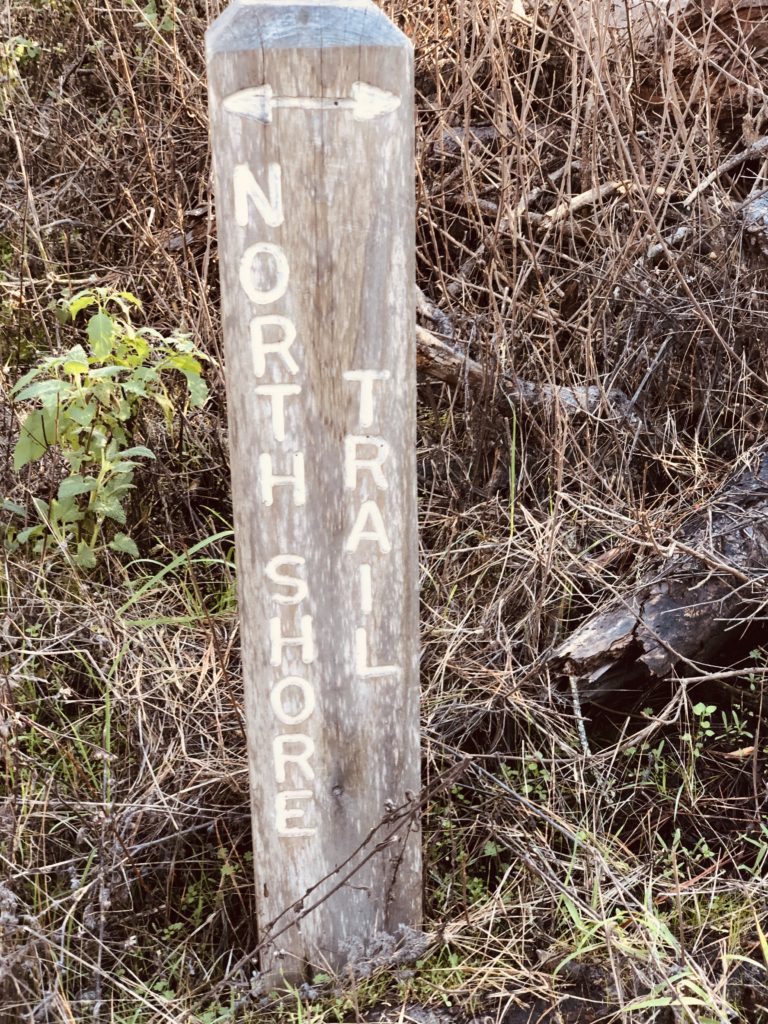
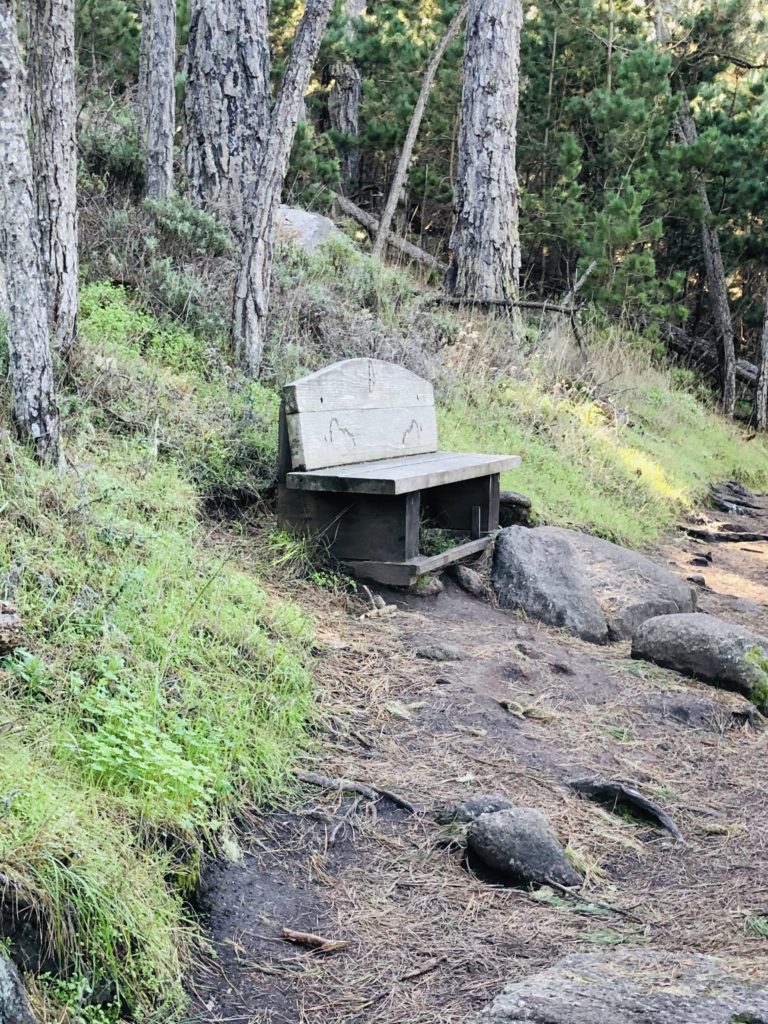
Numerous benches are placed along all trails, offering a place to enjoy a picnic lunch or simply contemplate the beauty around you. 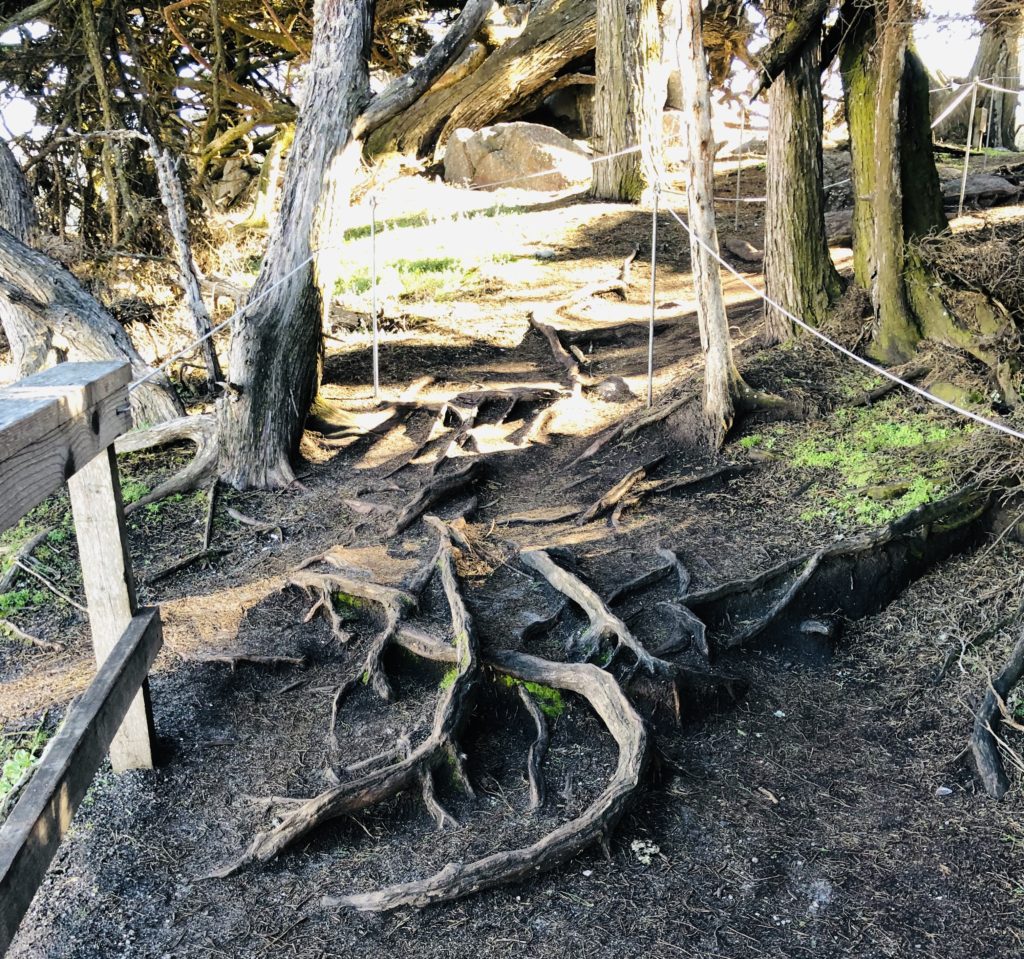
Beware the tree roots! Point Lobos offers poetry walks on Wednesday afternoons. Apparently, these are led by a docent with sojourns to various spots to contemplate the area’s beauty and write poems. While I love poetry I will refrain from attempting to entertain you with one of my own concoctions. I recommend that they also host Plein Air wine & paint sessions, I would definitely sign up for that!
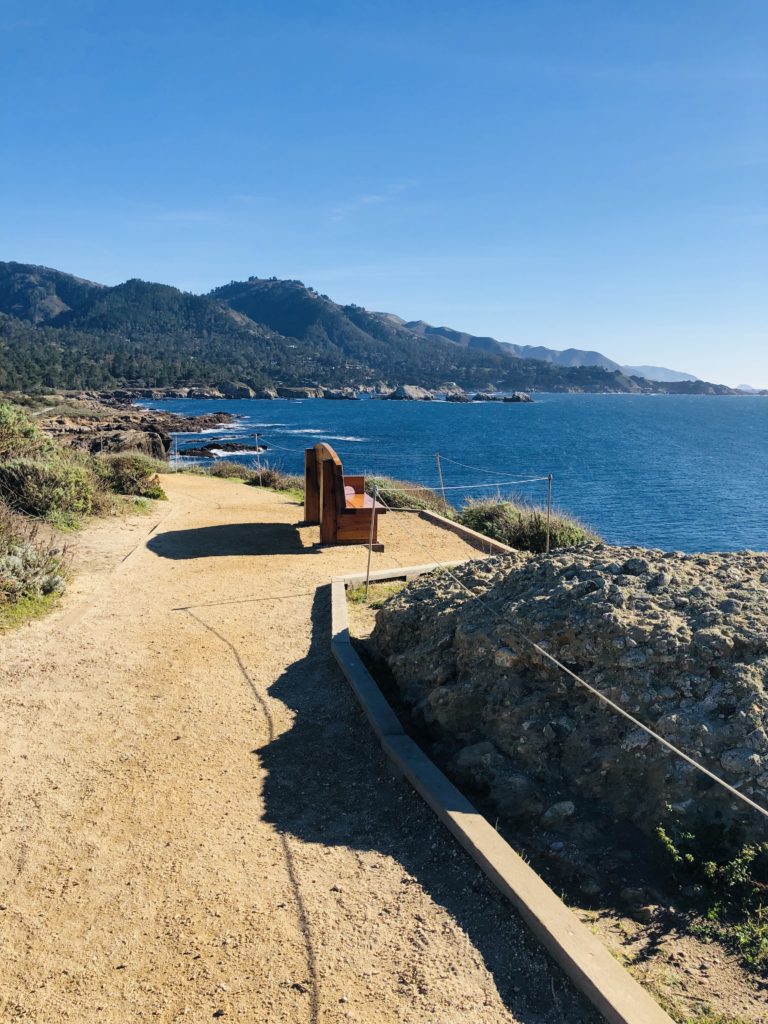
I think that if you only have time to do one hike in the Monterey area, this is it. It has trails for all levels and it has spectacular, unparalleled views. I would personally rate Point Lobos a 10 and also give it summa cum laude honors. You will not be disappointed!
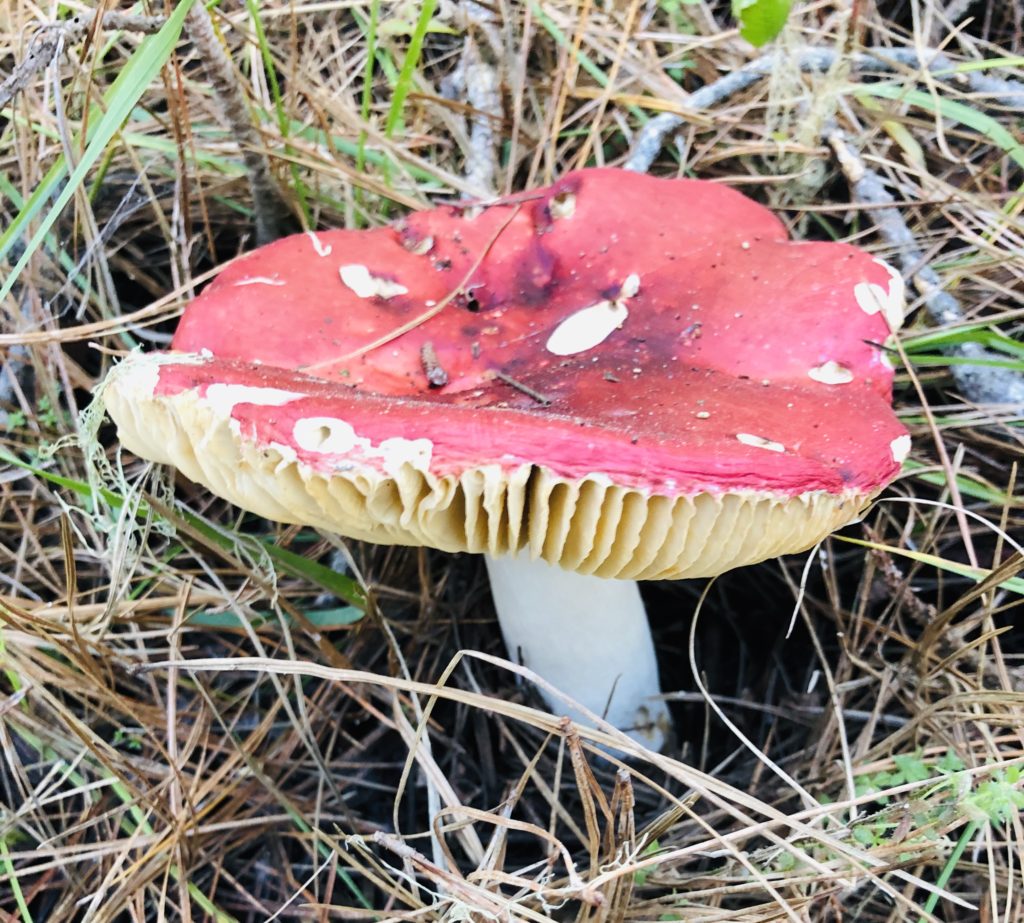
These fungi were everywhere at Point Lobos. I do not think they are edible but they are very pretty! Point Lobos is open daily from 8 am to 5 pm. For more information, see Point Lobos.
HELPFUL HINTS:
- Park alongside Highway 1 just south of Monastery Beach for free and follow the path to the entrance as inside parking is usually full.
- I recommend coming during the week as weekends can be crazy busy!
- Dogs & Horses are not allowed.
- Smoking is forbidden. (Although when I was there, a girl was quite flauntaciously smoking whilst hiking. I made that word up, by the way; it is a combination of flaunt and ostentatious. Basically, she was being a stinker doodle.)
- Bicycles are not allowed on the trails.
- Fishing is not allowed.
- Restrooms are available at the parking lots at both the beginning and end of the North Shore Trail.
- Kayaking and Scuba diving are allowed. Bring your own stuff, because no equipment rentals are provided. A popular scuba diving area is at Whaler’s Cove. You can make reservations up to three months in advance. For more information see scuba diving.
- Binoculars may be checked out from the information station to view sea otters, seals, whales, and birds.
- Wear layers of clothing as it can be chilly and windy at times.
Thank you for visiting my blog! Wishing you peace, love, happiness, and beautiful vistas!
-
Foraging for Fungi in Beautiful Big Sur
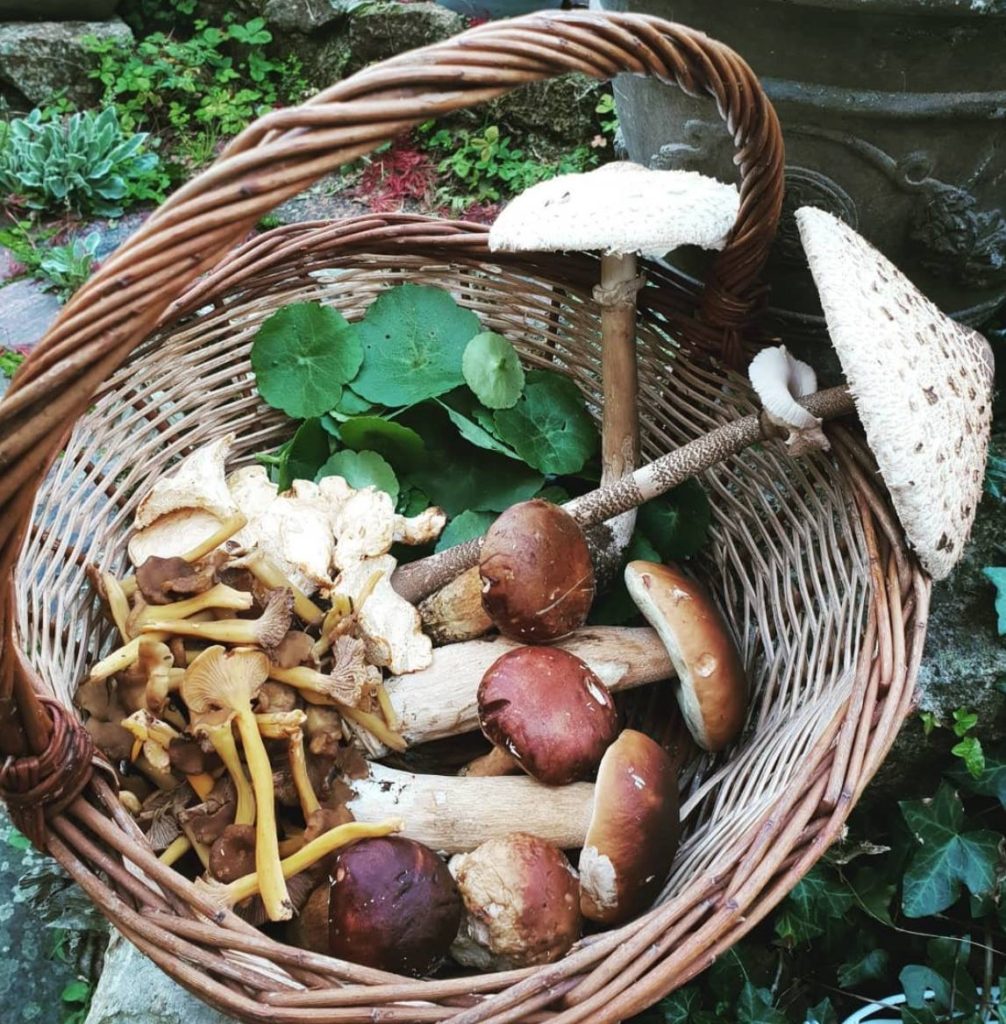 January is peak mushroom season in central coastal California. Each year the Big Sur area hosts a four-day Foragers Festival to raise money for the Big Sur Health Center, a non-profit facility that provides much needed local medical services. Multiple well-known restaurants and renowned chefs create magical meals featuring wild ingredients foraged in Big Sur paired with delicious local wines and beers. There are also raffles, auctions, and a “Fungus Face-Off”, which pits local chefs against each other in a cooking competition featuring fungi. While I have been known to consume mushrooms on my pizza and occasionally partake of portobellos I must admit that my knowledge of mushrooms is rather scant. Mushrooms are ubiquitous at my farm and I always wonder if they are edible or poisonous, so when I saw that the festival included foraging hikes led by fungi experts, I jumped at the chance.
January is peak mushroom season in central coastal California. Each year the Big Sur area hosts a four-day Foragers Festival to raise money for the Big Sur Health Center, a non-profit facility that provides much needed local medical services. Multiple well-known restaurants and renowned chefs create magical meals featuring wild ingredients foraged in Big Sur paired with delicious local wines and beers. There are also raffles, auctions, and a “Fungus Face-Off”, which pits local chefs against each other in a cooking competition featuring fungi. While I have been known to consume mushrooms on my pizza and occasionally partake of portobellos I must admit that my knowledge of mushrooms is rather scant. Mushrooms are ubiquitous at my farm and I always wonder if they are edible or poisonous, so when I saw that the festival included foraging hikes led by fungi experts, I jumped at the chance.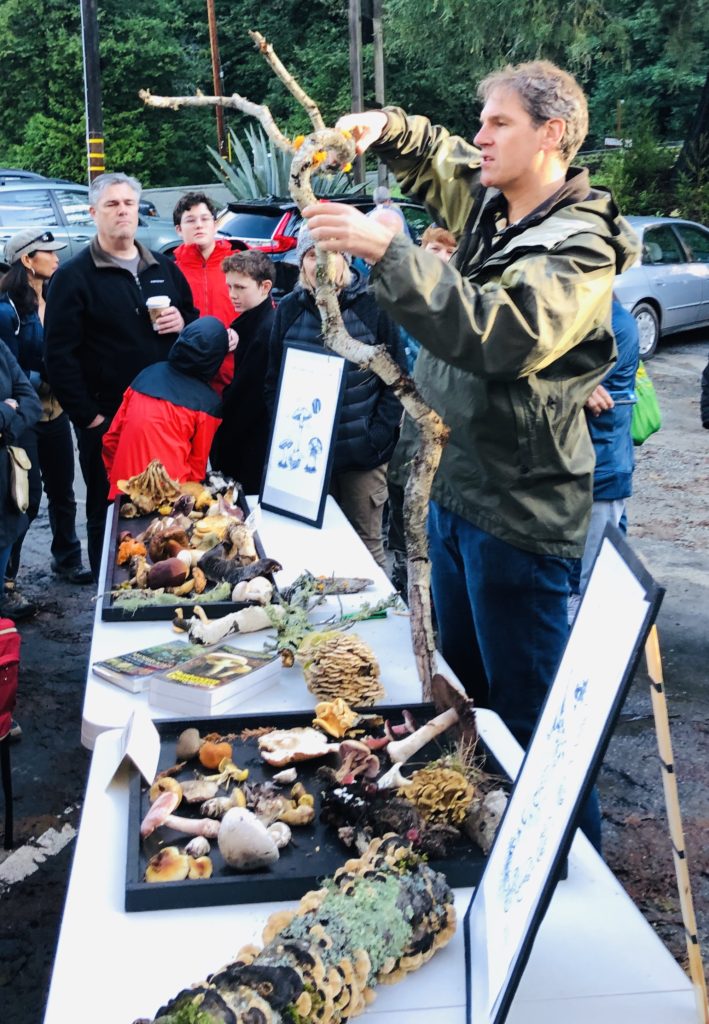
The hikes were led by Todd Spanier, who truly is a walking encyclopedia of knowledge as well as a talented chef. I liked that he could not only identify wild plants and fungi, but also explain how they could be used for culinary purposes. He explained that he started learning about mushrooms from his Italian grandfather when he was only five years old. Todd owns a company called “King of Mushrooms” which provides wild foraged foods to many local restaurants and businesses. He is considered to be a pioneer of the sustainable and wild food movements in California. If you would like to join Todd or other experts to learn about wild edibles, see Wild Food Walks.

The Good (Edible) Fungi. 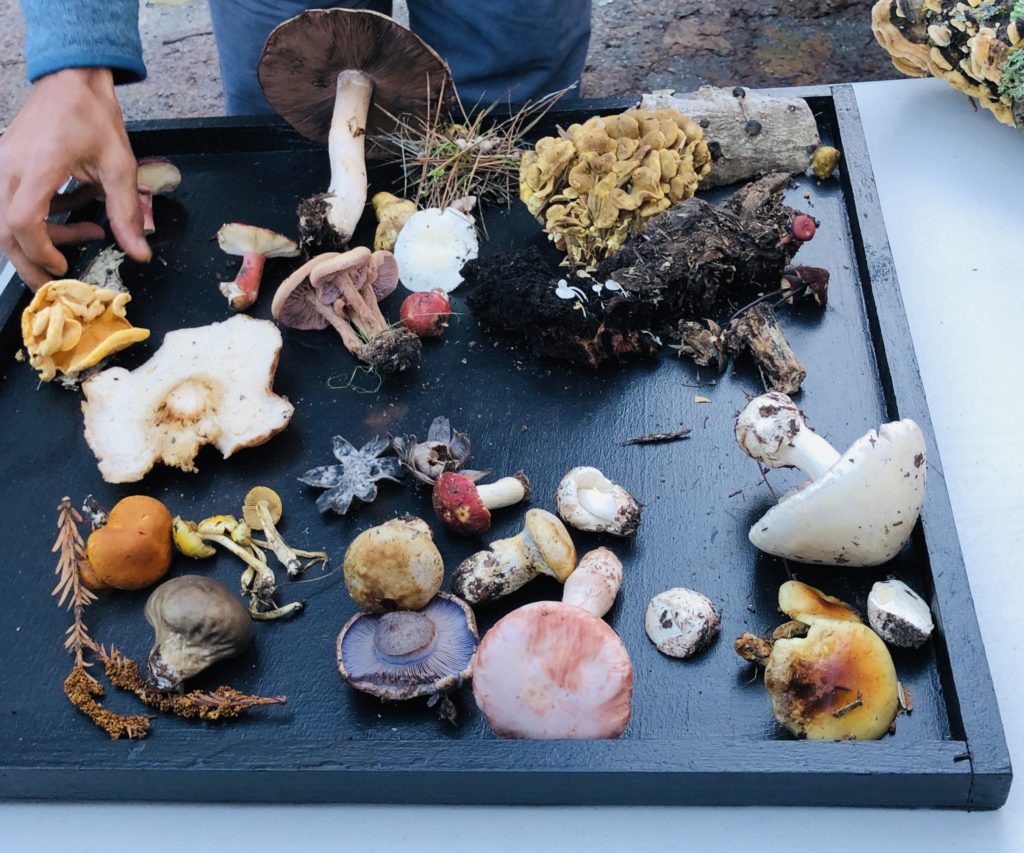
The Bad (Won’t Kill You But Yucky) Fungi. I learned that the biggest threat to fungi is not over picking, but rather, destruction of their habitat. I also learned that you can touch poisonous fungi and not worry about getting sick, that the only way to become ill is if you ingest the mushroom. Stories were also related regarding people from Asia and Russia coming to California and picking and eating mushrooms that looked identical to those in their original countries but which were toxic and poisonous. You can imagine the dire consequences. Yikes!
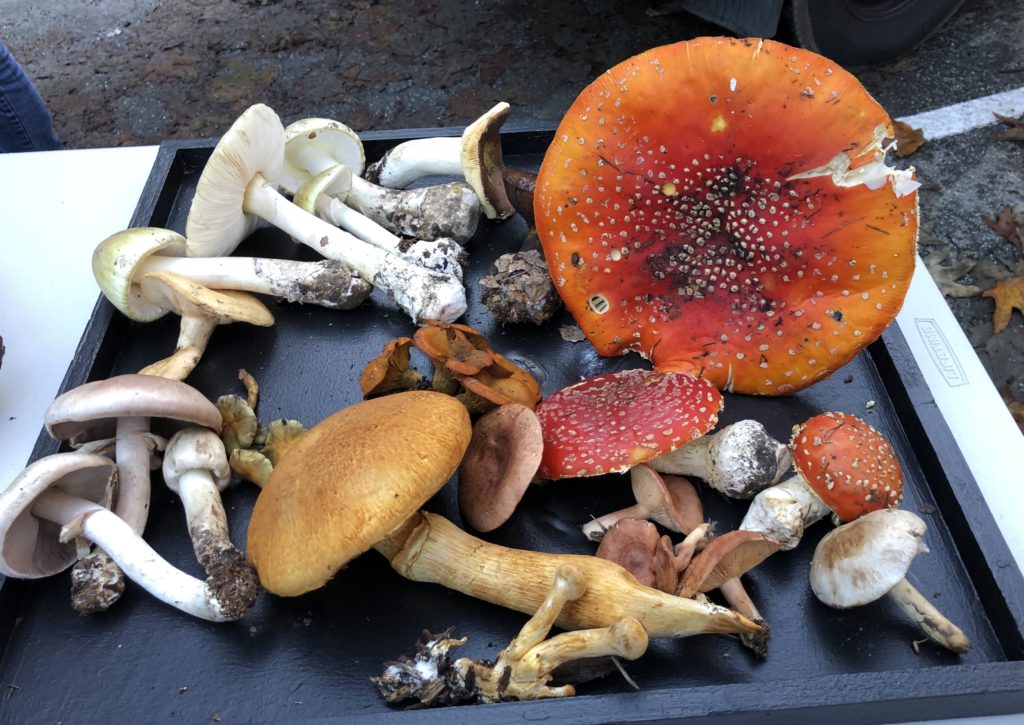
And the Ugly (Poisonous) Fungi. 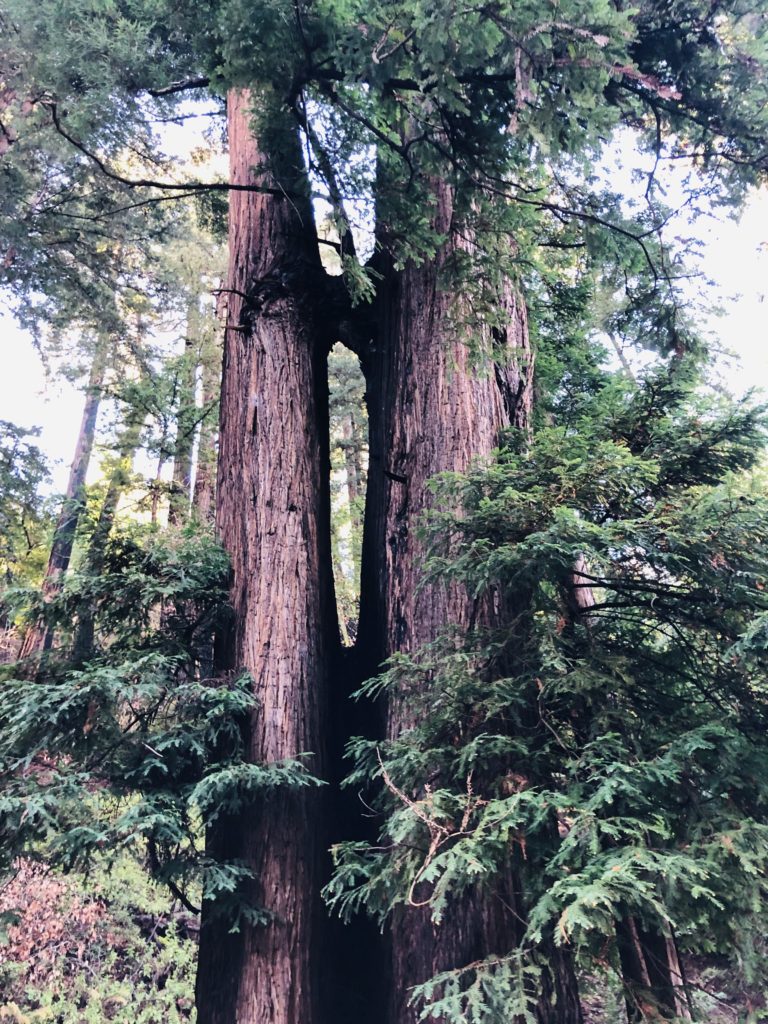
Conjoined redwoods along the way. It was a beautiful, sunny day as we entered the Big Sur forest following days of rain. We passed gorgeous copses of redwoods, bay laurels, and canyon oaks. Lauren, another of our guides, was very knowledgeable regarding edible items and pointed out horsemint, miner’s lettuce, and redwood sorrel.
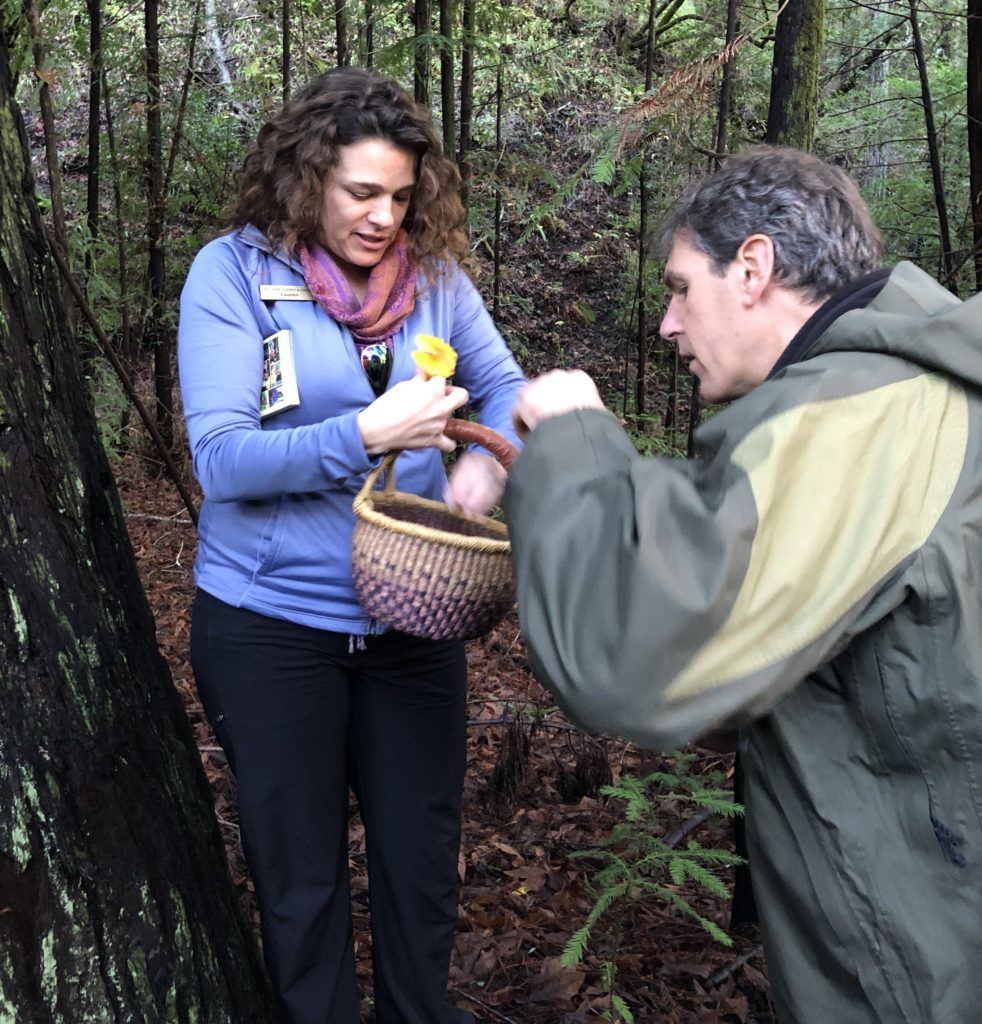
Lauren & Todd identifying our finds. 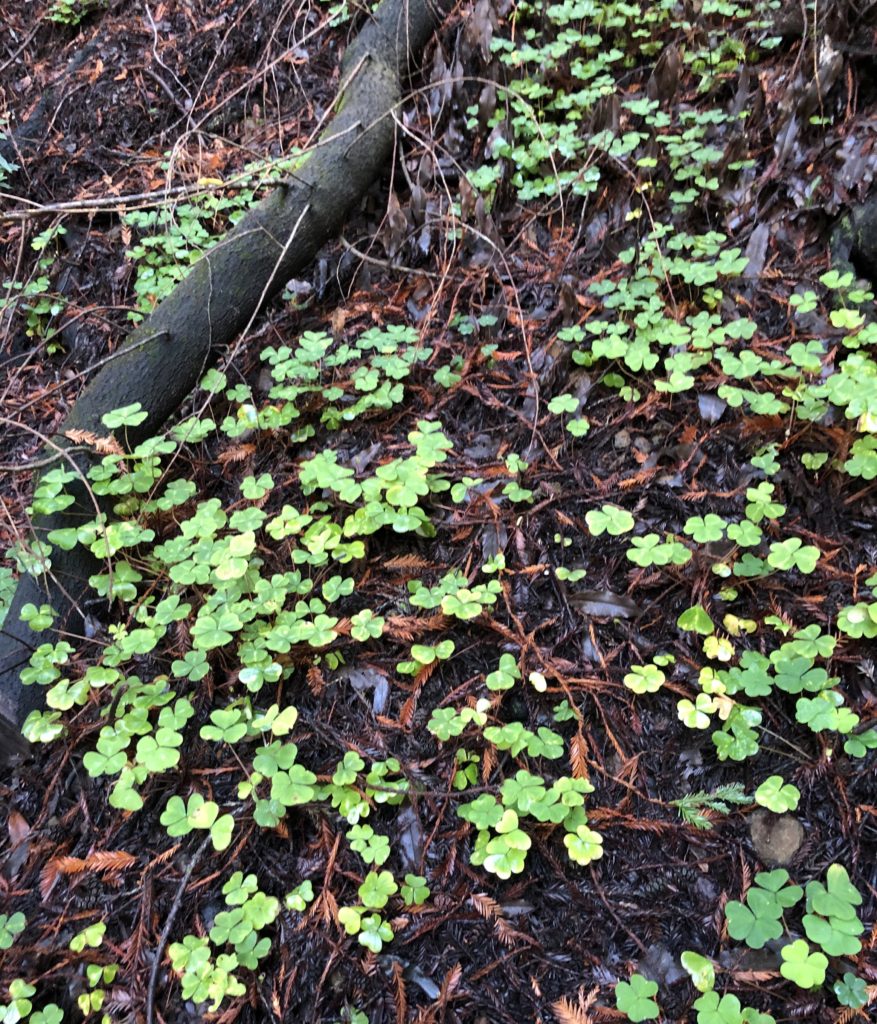
Redwood sorrel tastes like a tart green apple but should only be eaten in small quantities due to oxalic acid. 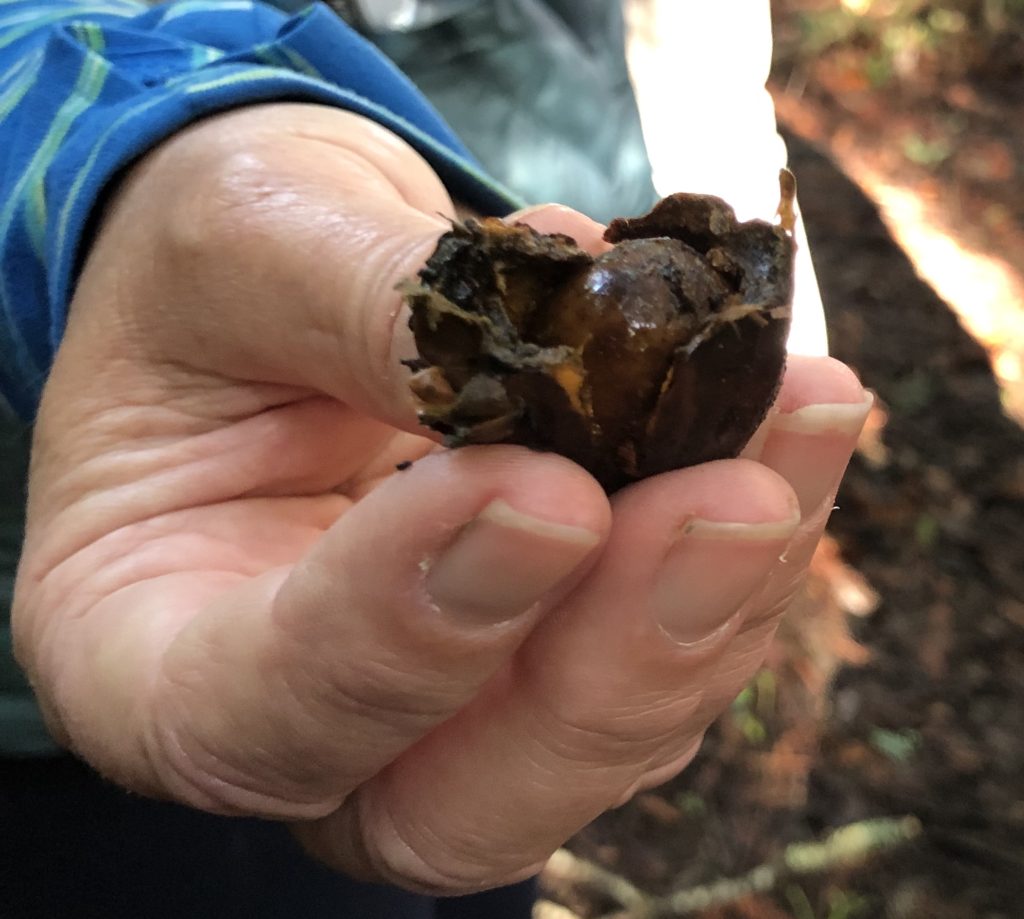
This is a nut, unfortunately, I do not remember the name! As many of you may know, I have a word obsession. I love learning new words, wordplay, etc. So, of course, I was stoked when I started learning about all the amazing fungi out there! Scientific nomenclature is interesting, but who can beat names like “Witches Butter”, “Candy Caps”, “Turkey Tails”, and “Slippery Jacks”?
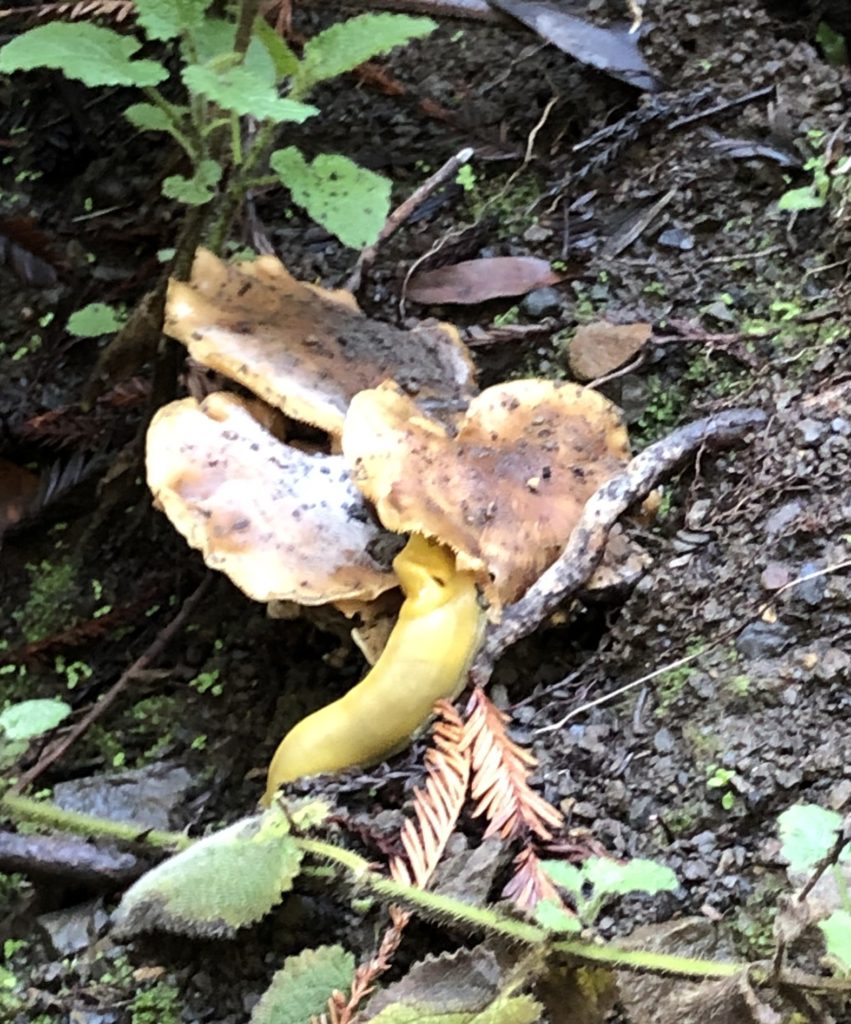
A banana slug feasts on honey mushrooms. Banana slugs were everywhere. Imagine my surprise when I learned that some younger males were licking them! I asked one kid why, and he said “licking a banana slug numbs your tongue and is a rite of passage.” Ewwwww. Boys are just weird.
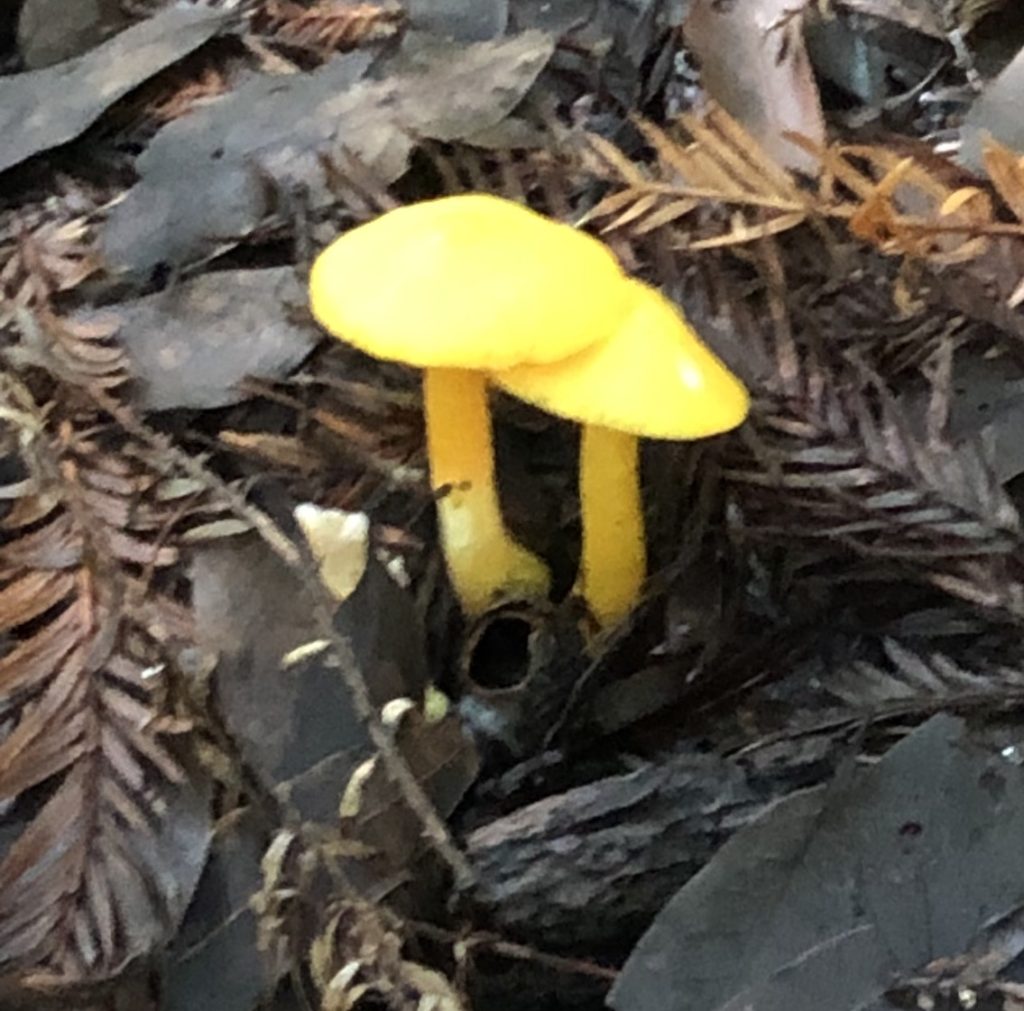
We saw many of these “Waxy Caps” on our hike. 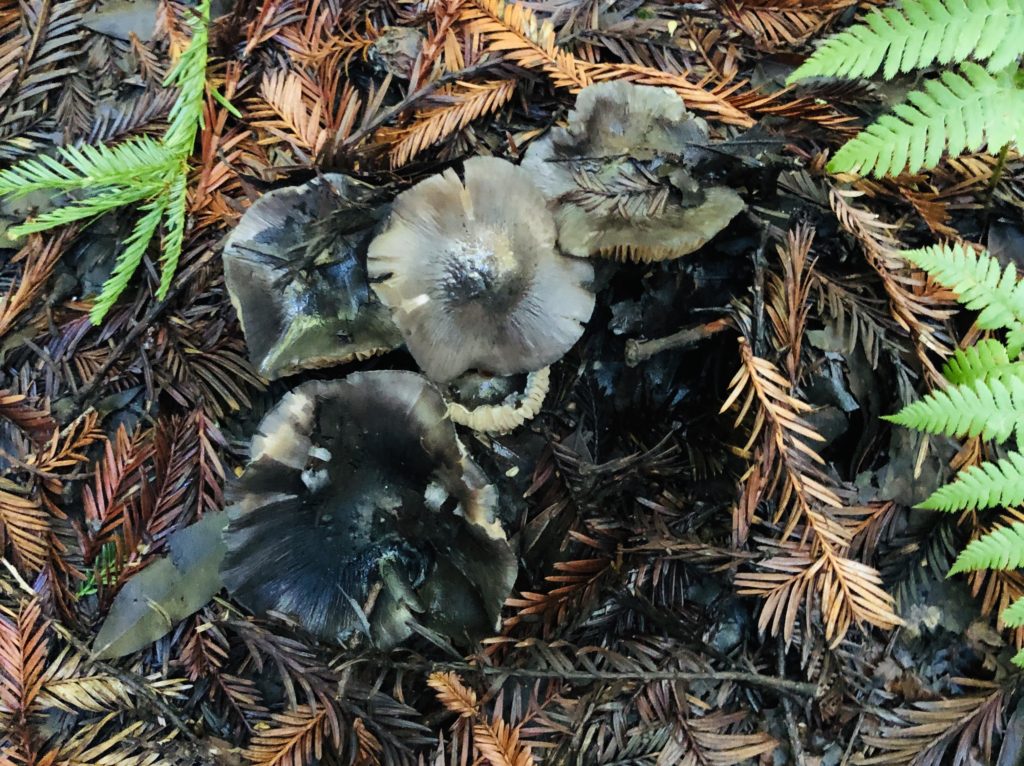
These “Black Knight” mushrooms were once popular in Europe but eating them over time can cause a toxic reaction. Avoid! Todd’s Takeaways:
- “Do not believe what you see on the internet.”
- “Do not eat mushrooms raw, you can get sick.” He stated that cooking mushrooms also enhances their nutritional value.
- “Know the tree, know the mushroom.” He said you can often tell what a mushroom is according to the tree it grows on or near.
- “Never eat a mushroom unless you are 100% sure of what it is”. There are some look-alikes that can befuddle even seasoned fungi seekers.
- “Use guidebooks to help identify fungi”.
Todd ended his hike by telling us “it doesn’t matter where we’re from, mushrooms connect us to nature and to our ancestry.” I for one would love to learn more and will be perusing my local library and also attending more foraging hikes. The best way to learn is from people who know their stuff, right? Whether you are a foodie, a nature lover, interested in sustainability, or just find the idea of foraging for wild mushrooms fascinating, you will enjoy this amazing experience. I can’t wait to try out more activities at the Big Sur Foragers Festival next year! For more information on this unique event, see Festival.
Thank you for visiting my blog! Wishing you peace, love, happiness, and beautiful vistas!
-
Cannery Row: What to See & Do!
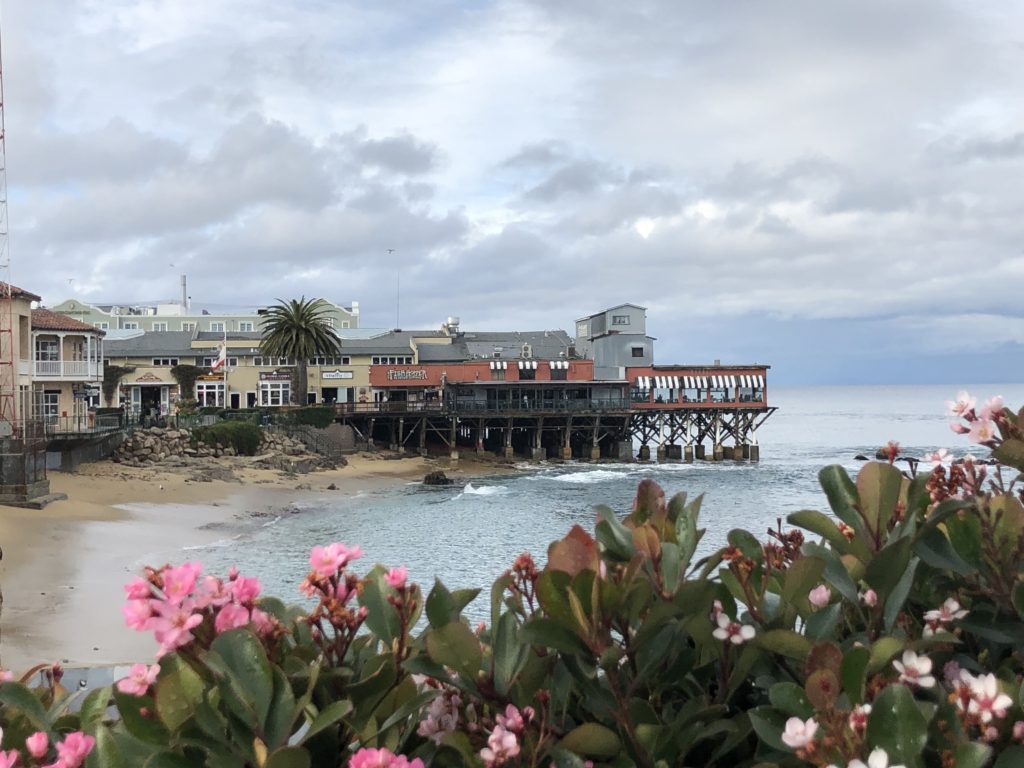
The view from McAbee Beach cameos some of Cannery Row’s fabulous restaurants and shops. If you are visiting Monterey, Cannery Row is probably one of the top things on your bucket list. Full of colorful history and nestled next to the picturesque bay, it is a must see. To understand this area, first a little history. Monterey, California was once the sardine capital of the world. The first sardine cannery was built by Frank Booth at Fishermen’s Wharf in 1896, and was soon followed by a rival Japanese sardine plant at Cannery Row called the Pacific Fish Company. Fishing boats loaded sardines into floating wooden hoppers, and they were sucked ashore through massive pipes. At Cannery Row, once called Ocean View Avenue, more than eighteen canneries eventually worked around the clock to fill sardine tins. John Steinbeck described the scene in his book, Cannery Row: “The whole street rumbles and groans and screams and rattles while the silver rivers of fish pour in out of the boats and the boats rise higher and higher in the water until they are empty. Then from the town pour men and women in trousers and rubber coats and oilcloth aprons. They come running to clean and cut and pack and cook and can the fish.” The overhead bridges allowed fish to be moved from one side of the factory to the other, and remain a testament to Monterey’s history. Unfortunately, overfishing led to the collapse of the sardine industry, and by the mid-1950s, Monterey turned to tourism to replace the sardine industry.
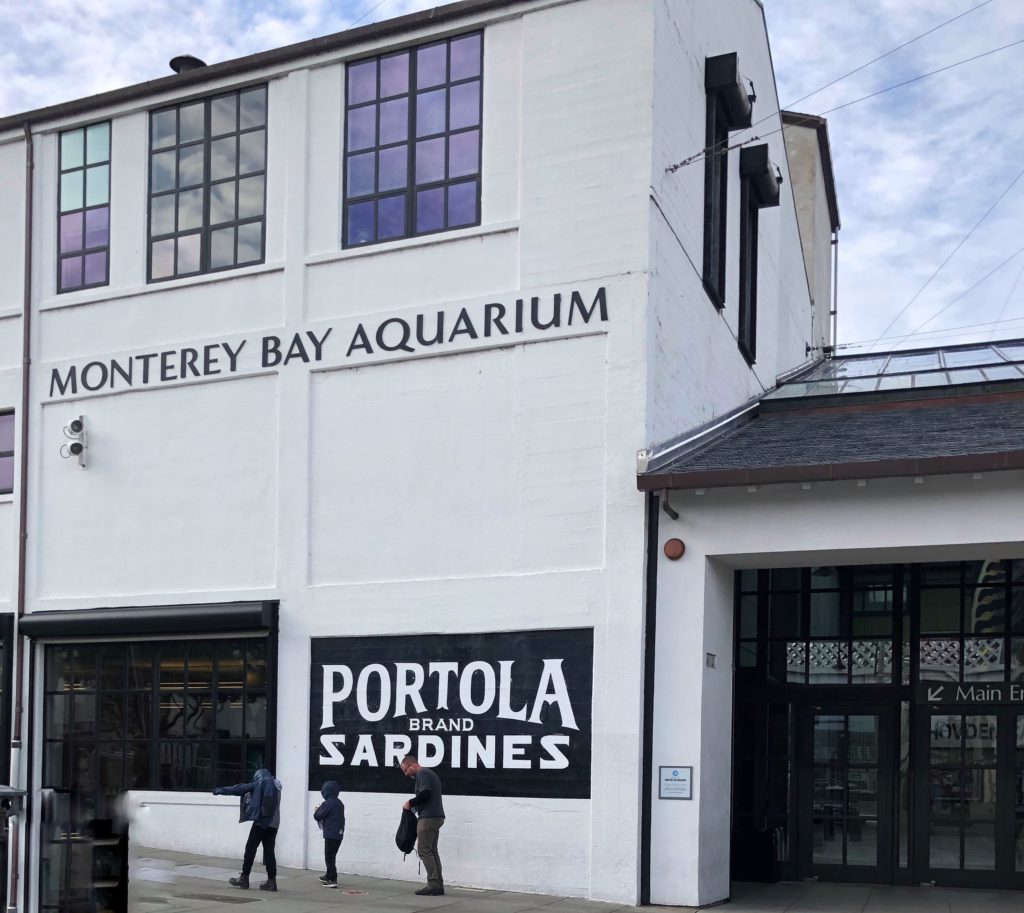
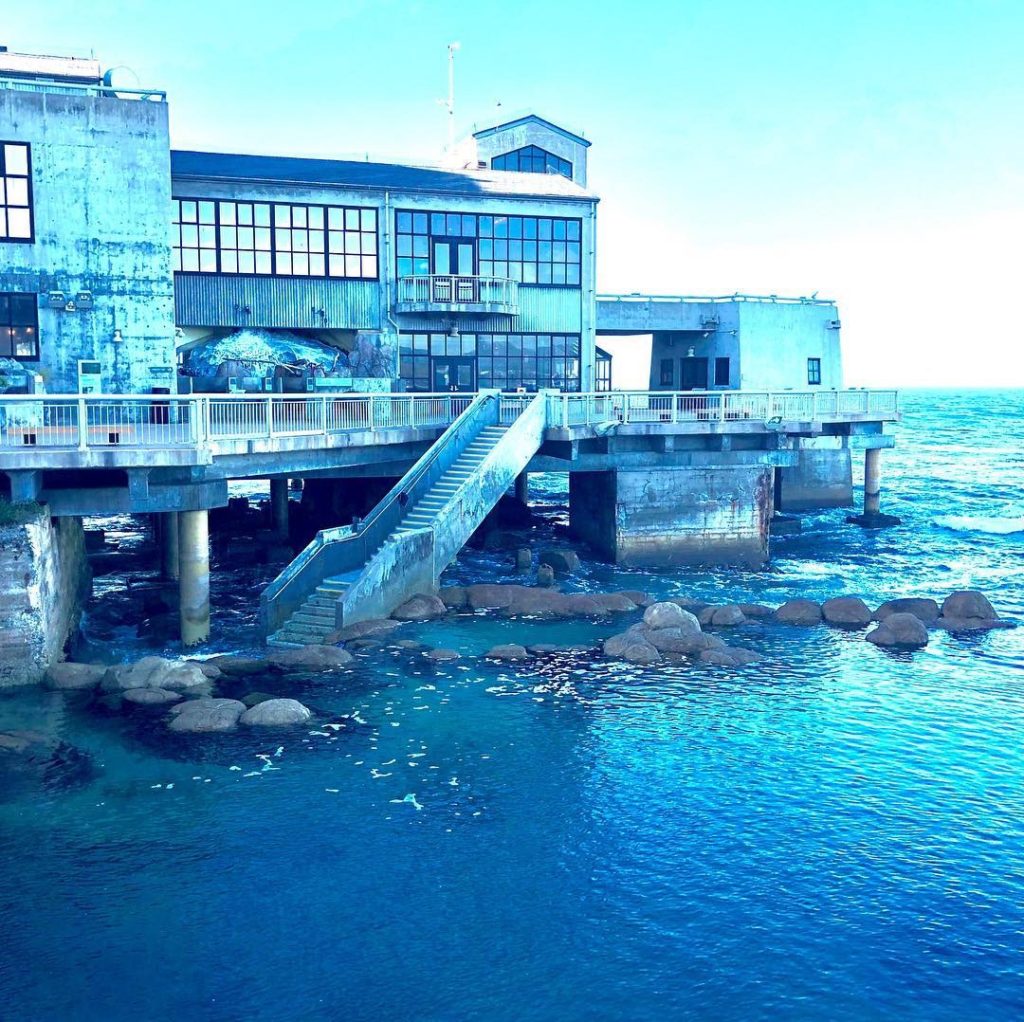
The rear view of the Aquarium is much more interesting than the front view! What to See & Do
1. EXPERIENCE THE AQUARIUM
The #1 thing to see here is the amazing Monterey Bay Aquarium. Because it is so magical and fantastic, I actually dedicated an entire blog post to it with tons of information, see Aquarium.
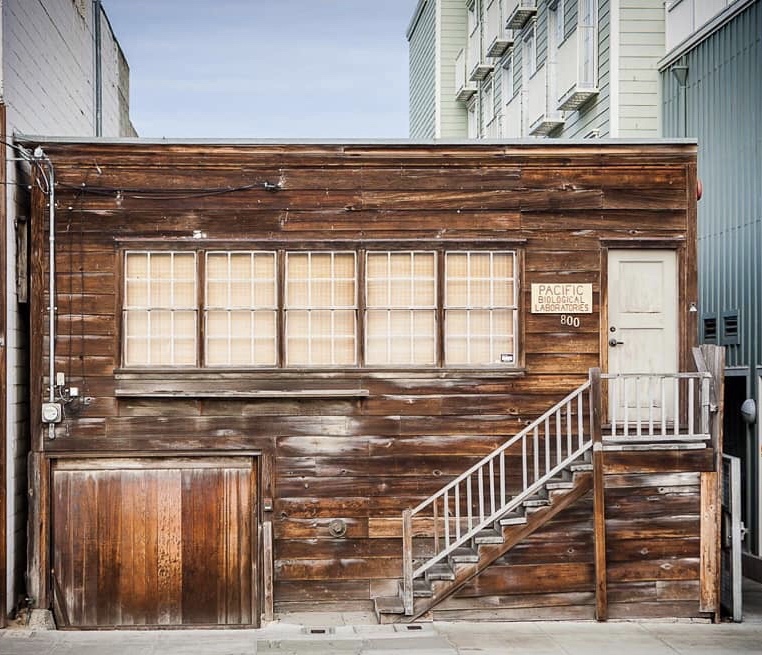
2. SEE STEINBECK’S OLD STOMPING GROUNDS
As you are strolling along, you may notice a dull and rather unassuming little building sandwiched in between the storefronts at 800 Cannery Row. This building was once home to the Pacific Biological Laboratories owned by marine biologist Ed Ricketts. Ricketts was a good friend of famous writer John Steinbeck. Together, Steinbeck and Ricketts spent much time together at “Doc’s Lab”, as it was known, preserving specimens and talking about philosophy. It has been said that Steinbeck’s biological and scientific training supported his notion of all humans as part of a greater ecosystem and his focus on the environment in his writing. Ricketts influenced several of his novels, including Cannery Row, Sweet Thursday, In Dubious Battle, The Grapes of Wrath, The Moon is Down, and The Sea of Cortez. The city of Monterey schedules free public tours of the building throughout the year. For more information, call 831-646-5640 or see Free Tours.
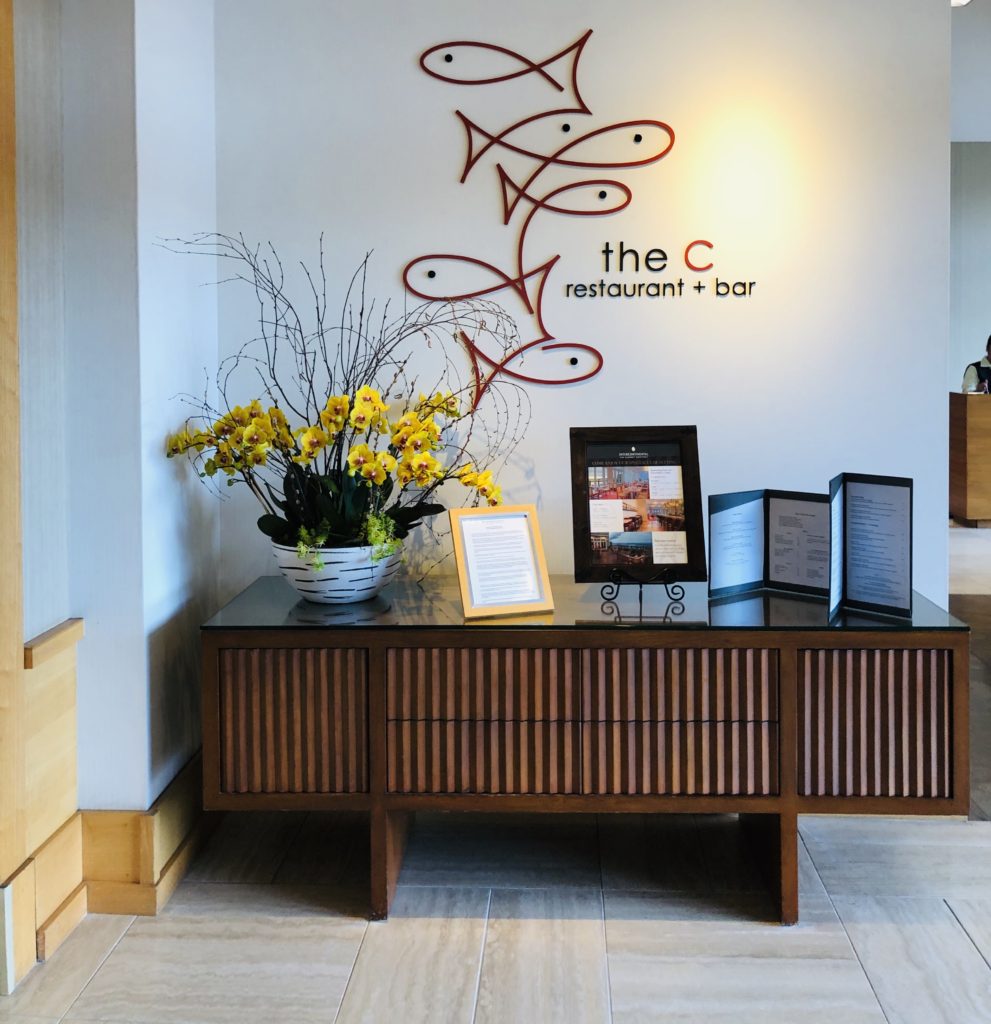
3. EAT AND DRINK
Foodies will love the plethora of restaurants available, including fresh seafood at The Fish Hopper, The iconic Sardine Factory, Lalla Oceanside Grill, the Whaling Station, and the C Restaurant & Bar, along with many, many more. If you choose a waterfront restaurant, be sure to ask for a table with an ocean view. You may be able to see sea lions, harbor seals, sea otters, dolphins, or even whales while you eat your meal! For more information see Restaurants.
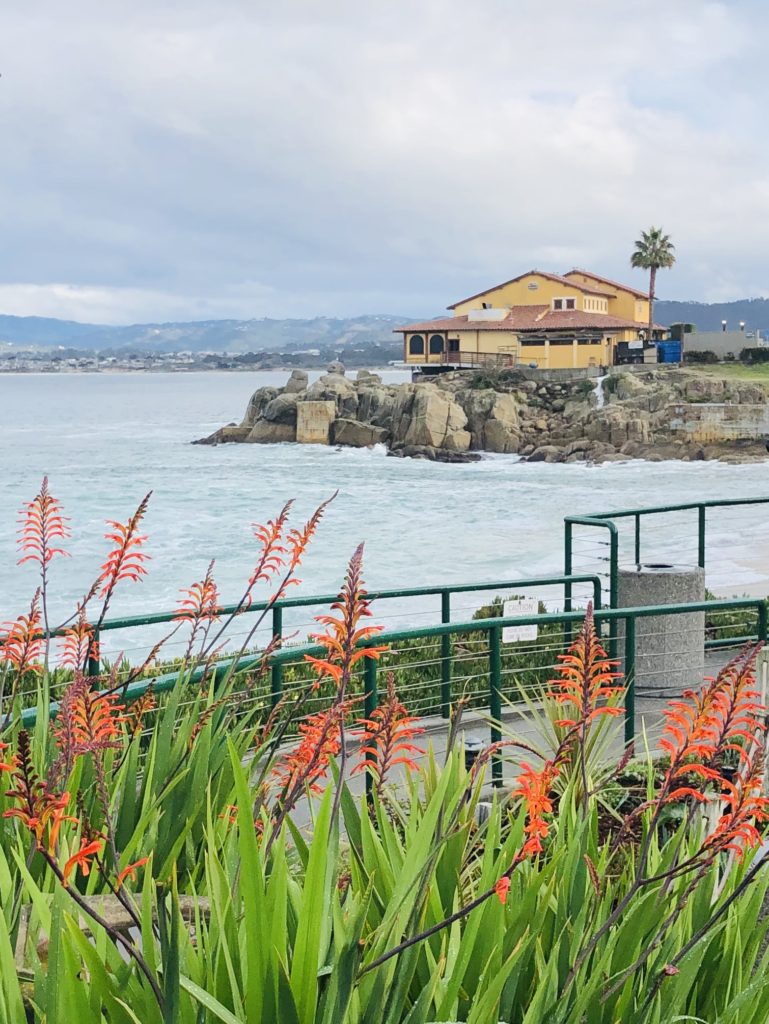
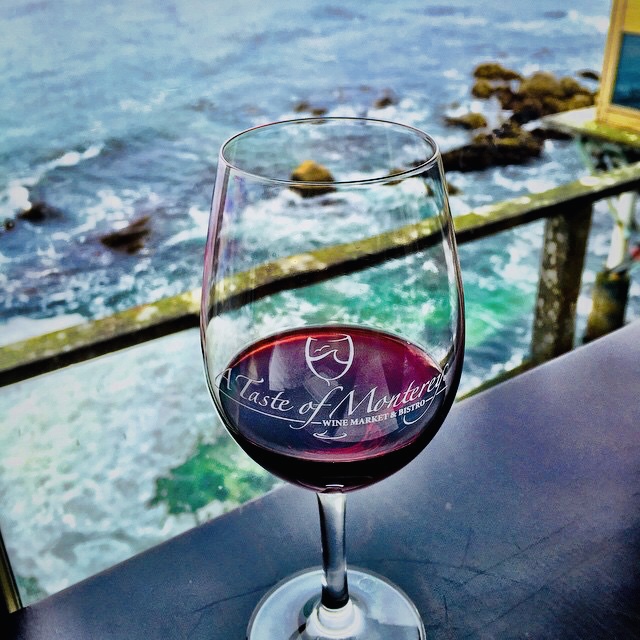
If you are keen-o for some vino, check out A Taste of Monterey, which is located near McAbee Beach and offers more than 90 local wines. Other great wine tasting rooms include Carmel Ridge Winery, Bargetto Winery, Blue Fox Cellars, and The Wine Experience. Have a glass or flight of wine while overlooking beautiful Monterey Bay. For more information, see Wine Tasting.
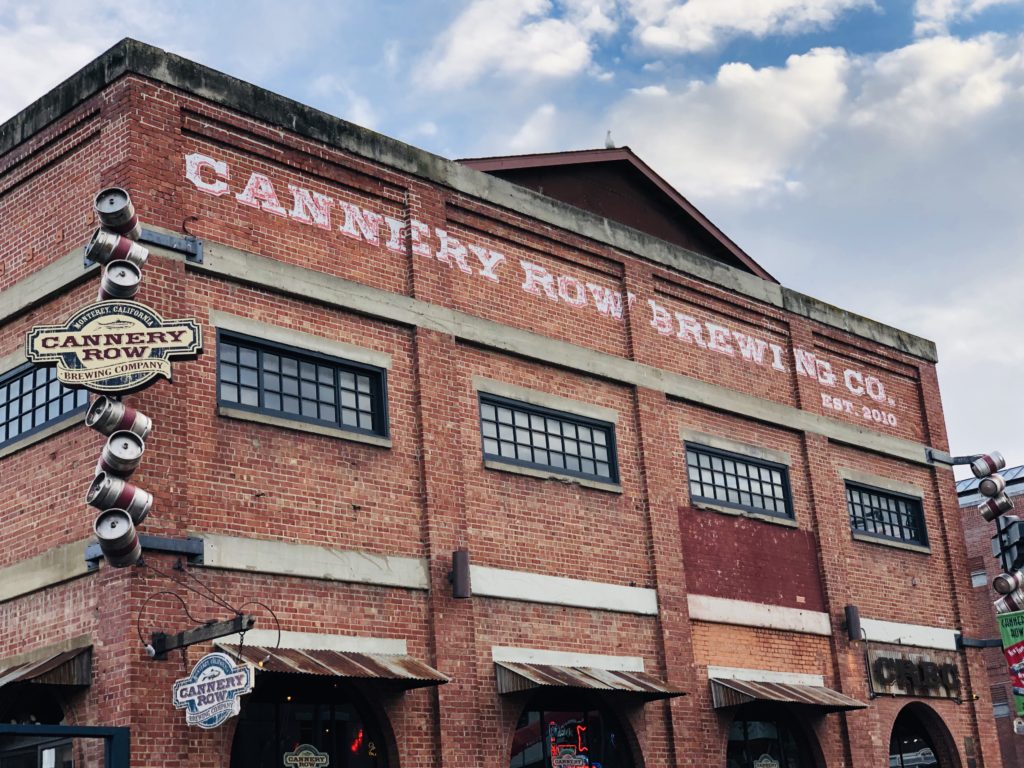
For all you beer enthusiasts (I hope my three brothers are reading this!) there is the Cannery Row Brewing Company, which has a warm pub feeling and offers lots of goodies to eat as well, including their signature giant pretzels. Located at 95 Prescott Ave. just two blocks from McAbee Beach, the brewery website states it “offers the second largest number of beers available on tap in Northern California and is the largest single outlet beer account in Monterey County.” Cheers to those beers!
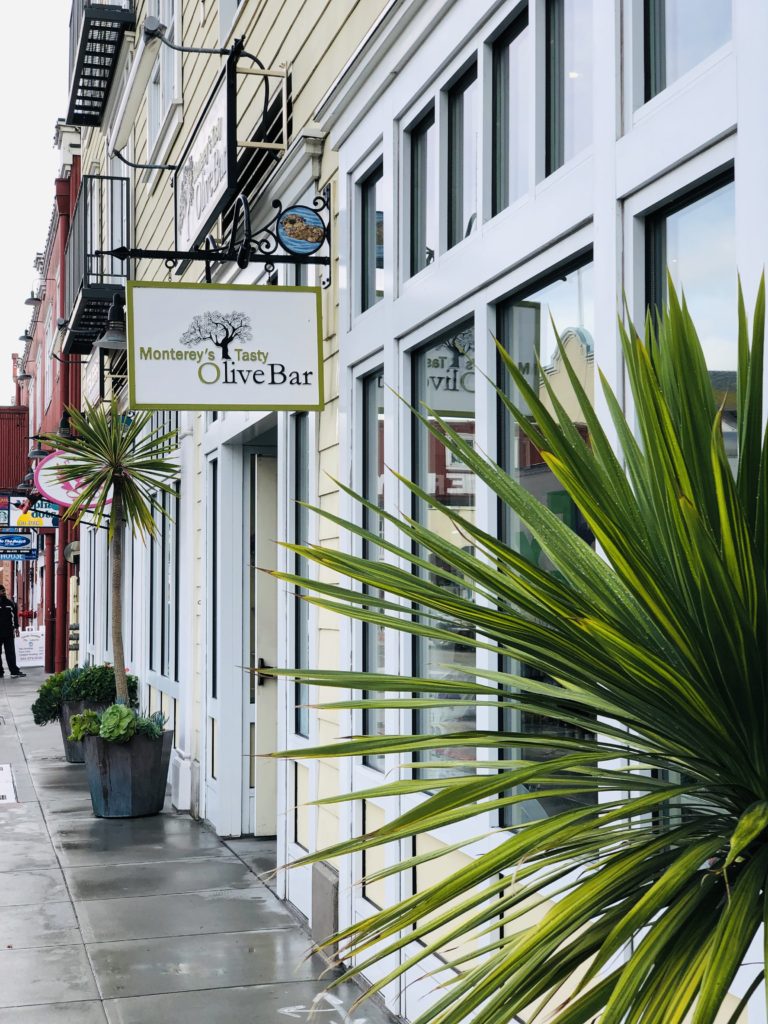
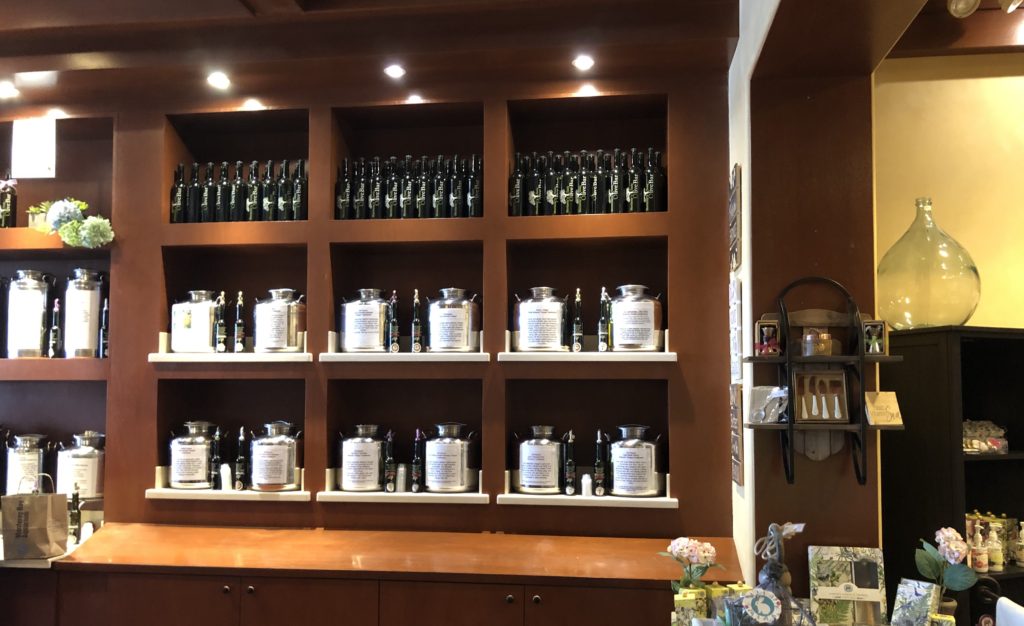
4. GO SHOPPING
Cannery Row is also home to over 85 shops within a four to five block area including boutiques, art galleries, jewelry and antique stores, candy shops, and gourmet food stores. My personal favorite is the Olive Bar. You can taste over 70 different varieties of olive oil and balsamic vinegar or peruse their gourmet food items and cute home and kitchen decor.
5. ACTIVITIES FOR KIDS
If your little whippersnappers get tired and bored looking at all the aforementioned shops, there are a couple of places they may enjoy. For kids and kids at heart, there is a Mirror Maze and Lazer Challenge and a Spirit of Monterey Wax Museum, both located just down the street from the Aquarium.
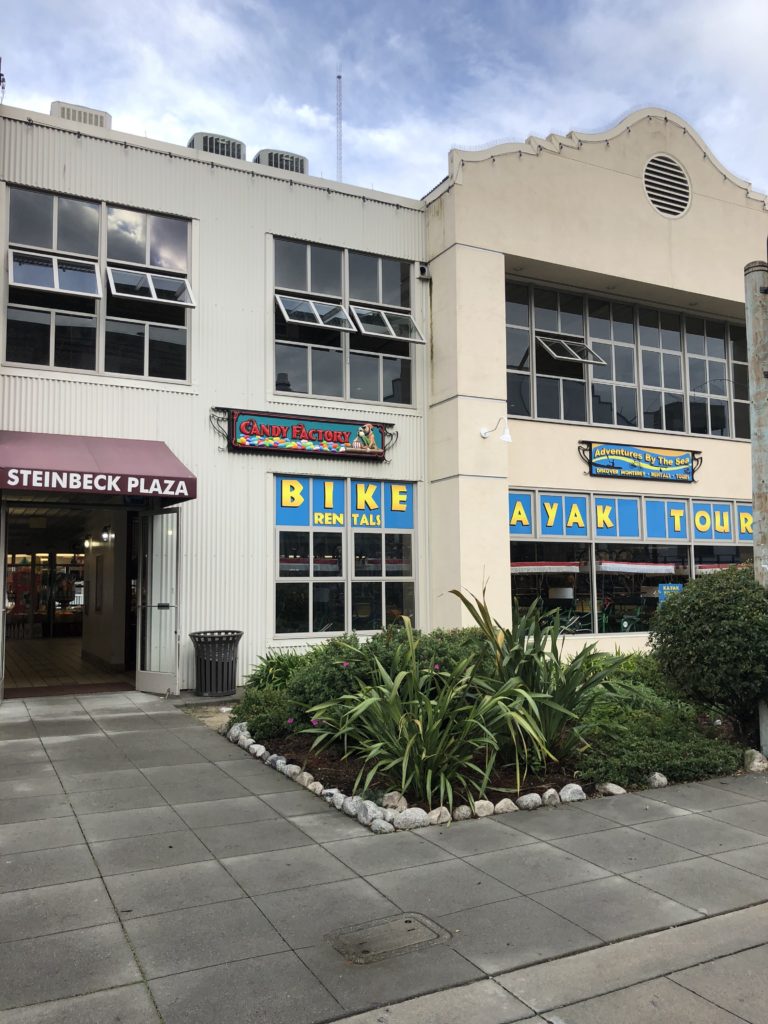
6. BIKE, KAYAK & PADDLE BOARD
For those of you interested in more physical activities, there are bike, kayak and paddle board rentals available so you can explore the area by both land and sea. Adventures By The Sea is conveniently located right next to the Recreation Trail and across the street from the beach where the kayaks are launched. Here you can rent family four-wheel bikes (called surreys), electric bikes and more. They offer group and private kayak tours of Cannery Row, paddle board lessons, and also bike tours of 17-Mile Drive. For more information, see By The Sea. Big Sur Adventures, located at 125 Ocean View Blvd, near the Aquarium, also offers bike rentals and tours. For more information, see Big Sur.
I hope you enjoy visiting Cannery Row! Wishing you peace, love, happiness, and beautiful vistas!
-
Point Reyes: Gateway to Adventure!
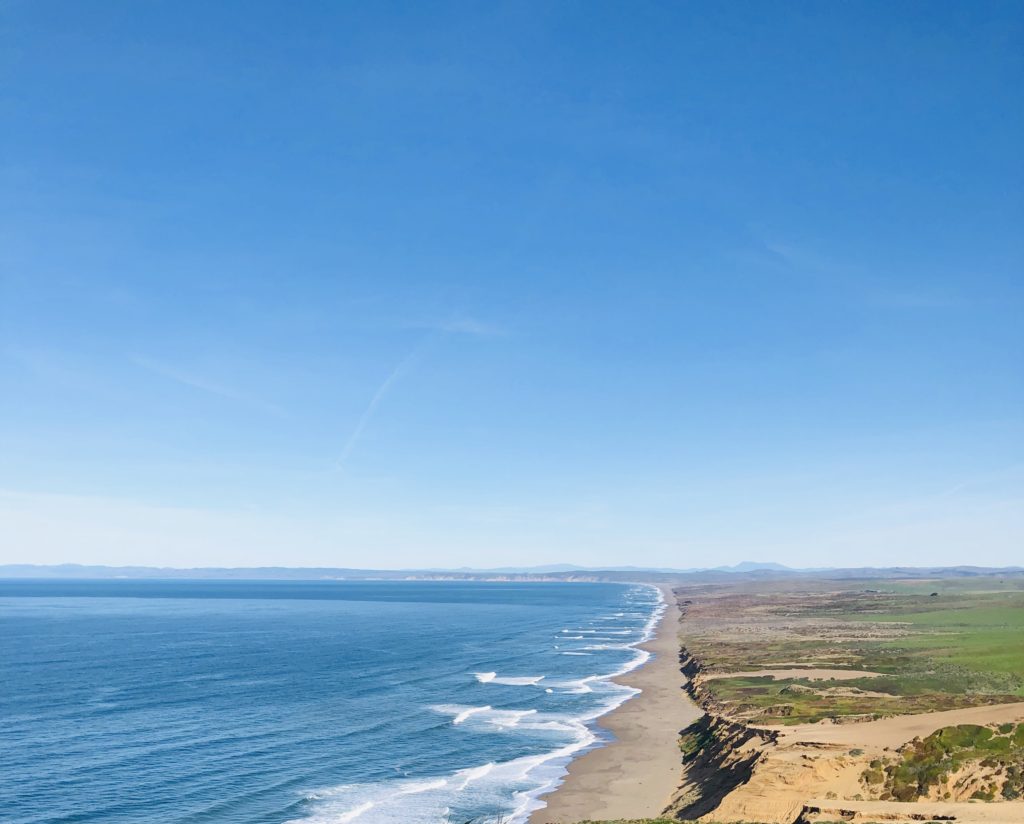 Point Reyes is an incredibly picturesque area located in Marin County. It is only about an hour and a half drive from San Francisco but it feels like you are in a different world here, with thousands of acres of wilderness, secluded villages, rolling hills with dairy farms, achingly beautiful beaches, and amazing wildlife. If you look at geologic maps, the San Andreas Fault Line slices through the area like a knife cutting the end off a loaf of bread. Point Reyes is the end of the loaf being cut off. It sits on the Pacific Tectonic plate, the same one as the country of Japan, while the rest of Marin County is on the North American plate. Point Reyes is basically an island that moved up the coast on this plate over millions of years to its present location. Apparently, Point Reyes Peninsula continues to move 3-4 centimeters a year towards the northwest. If it keeps moving it could ostensibly end up in Alaska or something. Crazy, right? Anyway, here are the FIVE most fun, must see and do things in the Point Reyes area.
Point Reyes is an incredibly picturesque area located in Marin County. It is only about an hour and a half drive from San Francisco but it feels like you are in a different world here, with thousands of acres of wilderness, secluded villages, rolling hills with dairy farms, achingly beautiful beaches, and amazing wildlife. If you look at geologic maps, the San Andreas Fault Line slices through the area like a knife cutting the end off a loaf of bread. Point Reyes is the end of the loaf being cut off. It sits on the Pacific Tectonic plate, the same one as the country of Japan, while the rest of Marin County is on the North American plate. Point Reyes is basically an island that moved up the coast on this plate over millions of years to its present location. Apparently, Point Reyes Peninsula continues to move 3-4 centimeters a year towards the northwest. If it keeps moving it could ostensibly end up in Alaska or something. Crazy, right? Anyway, here are the FIVE most fun, must see and do things in the Point Reyes area.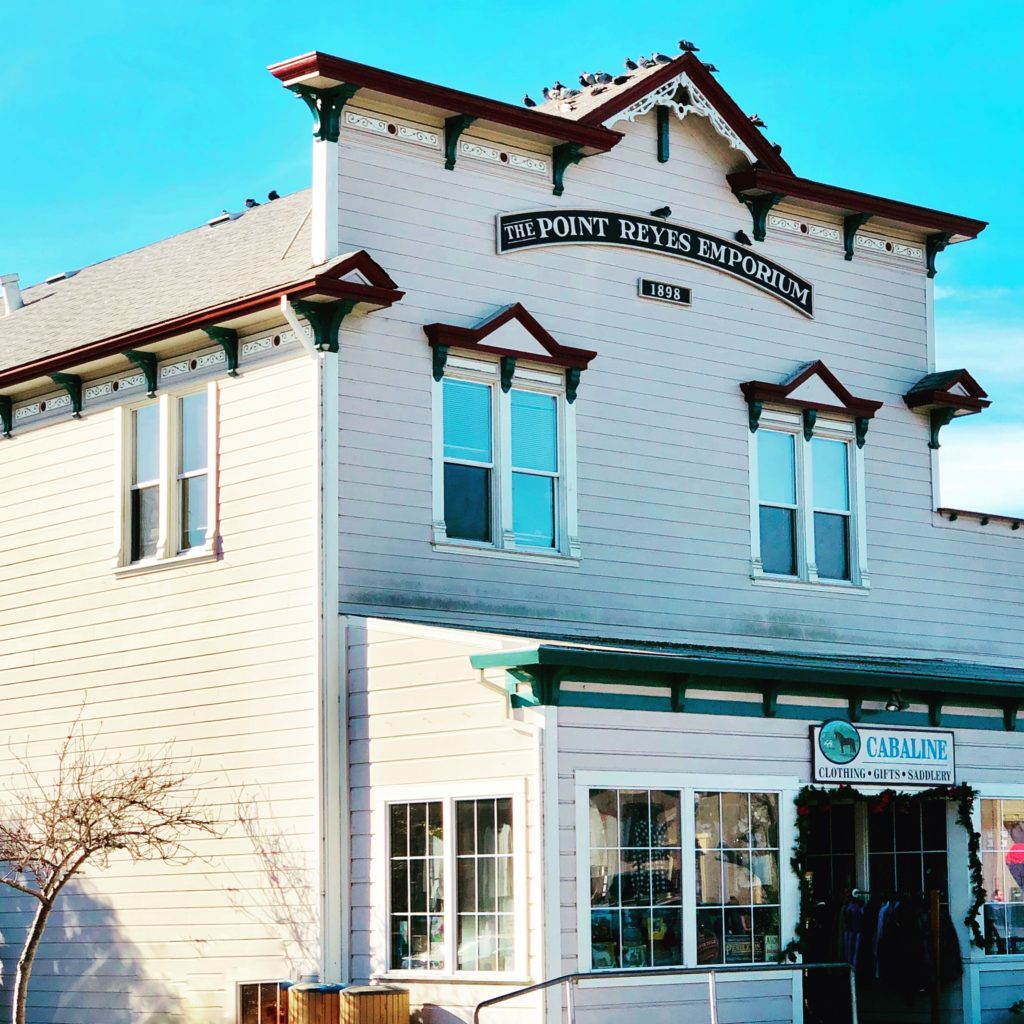
1. POINT REYES STATION
This tiny town, population 350, was previously a stop on the North Pacific Coast Railroad that connected the northern town of Cazadero all the way to its southern stop in Sausalito. After the great 1906 earthquake, this railway was used to haul redwood and other lumber to rebuild San Francisco. The wonderful old Victorian buildings in Point Reyes Station offer a glimpse of the past with a plethora of cute little shops and amazing restaurants. It is a great place to stop, shop, and eat. Places to eat here include Cafe Reyes which is known for its bomb diggety wood-fired pizza and fresh shucked local oysters and the Station House Cafe which serves everything from beer and burgers to fancier fare, all sourced from local farms and creameries. Station House Cafe has it all, from their quaint bar to their lovely outdoor garden seating and there is even live music on Sundays with no cover charge. The Bovine Bakery offers coffee, espresso, and yummy baked goods and soups. Cowgirl Creamery creates delicious artisanal cheeses as well as soups, salads, and sandwiches at their local digs. For more information on the unique food venues here, check out Where to eat in Point Reyes Station.
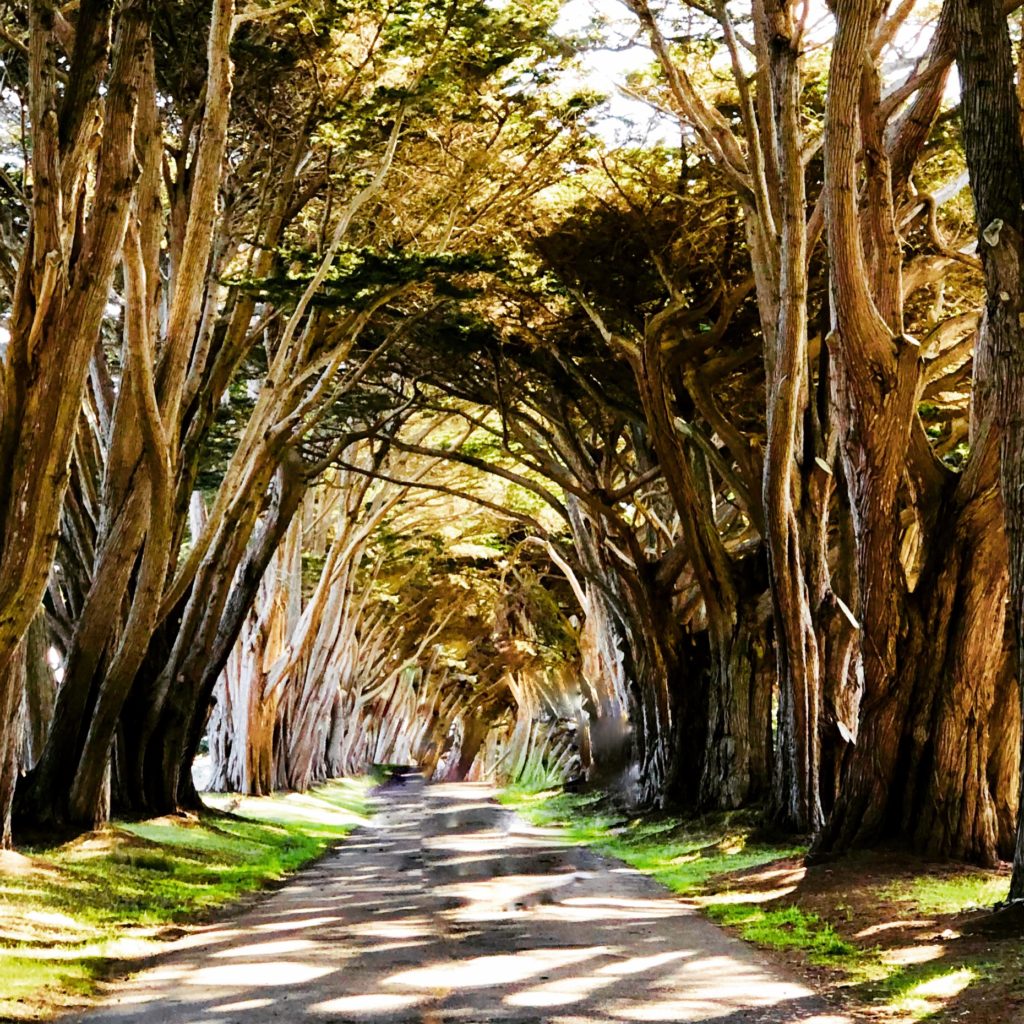
2. CYPRESS TREE TUNNEL & ART DECO RADIO STATION
From Point Reyes Station, take Mesa Road west to Shoreline Highway. Follow for .2 miles until you come to Sir Francis Drake Boulevard. Turn right and follow for 10 miles to see the famous Cypress Tree Tunnel. This has been photographed a gazillion times by probably every photographer on the planet because it is so ridiculously amazing. The cypress trees were originally planted in the 1930s. The road through the trees leads to an old white art deco building that houses the Point Reyes National Seashore North District Operations Center and the KPH RCA Radio Station. KPH is the only surviving Morse code coastal station in North America. It was created in the early 1900s and was called the “wireless giant of the Pacific”. For decades, it provided a communication link to ships at sea using telegrams and radioteletype. The station was nearly destroyed after it fell into disrepair, but fortunately, the Maritime Radio Historical Society, in conjunction with the Point Reyes National Seashore, came to the rescue. Today, you can hear KPH every Saturday from 12-4 pm. Special events and weekend tours are occasionally held at the station. For more information see KPH Maritime Radio Station. Where: 17400 Sir Francis Drake Blvd, Inverness, California. Note: The only roadside signage is for the “North District Operations Center” and is on the right side of the road adjacent to the Cypress Tree Tunnel. Visitors are asked to park along the highway or follow the driveway to the parking lot on the left end closest to the station. They request that you do NOT park along the driveway next to the cypress trees because it damages their roots. Save the trees, people!
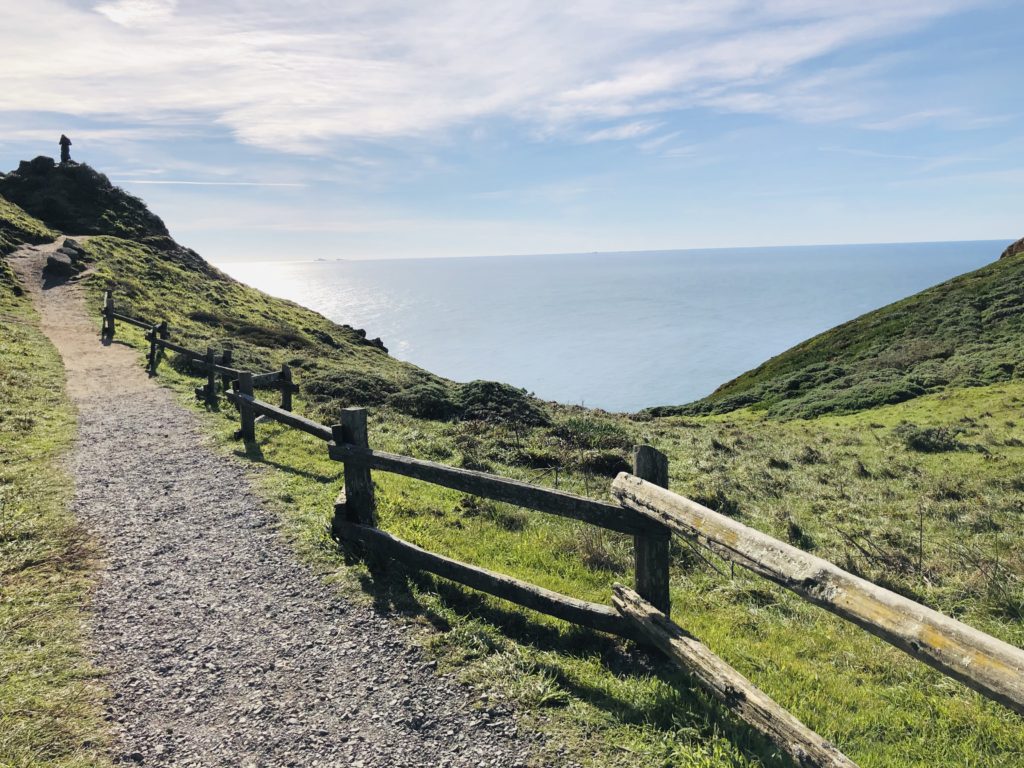

3. POINT REYES LIGHTHOUSE
Continue west on Sir Francis Drake Boulevard towards the Point Reyes Lighthouse. Your travels will become very lumpy, bumpy, and bouncy as you follow the road past bucolic farms with happily grazing Holsteins. These black and white bovines gave me warm fuzzies. They reminded me of my days as a cheesehead, living in the heart of dairy farm country in Wisconsin. The Point Reyes Lighthouse, a national historic landmark, was built in 1870. It was in service until 1975 when the Coast Guard installed an automated light below it. The lighthouse is currently owned by the National Park Service. Although it is not currently open due to restoration, you can follow its progress here: Point Reyes Lighthouse. The most current blog post indicates that it will be closed through January 31, 2019. Even with the lighthouse closed, this is a great area for hiking and has amazing vantage points to view the wind-swept coastline and possibly do some whale watching. If you want to wait and visit when the lighthouse is open, be aware that it is a .4 mile walk down 308 stairs down to the lighthouse. The lighthouse website indicates that they will return to their regular hours (Friday through Monday from 10 am-4:30 pm) once restoration is completed. Wear good walking shoes and bring a jacket as it can be chilly and windy. There is no entrance fee. There are restrooms in the parking area. Please remember to take your garbage with you and respect the property and wildlife here. Where: 27999 Sir Francis Drake Blvd. Inverness, CA 94937. Phone: 415-669-1534
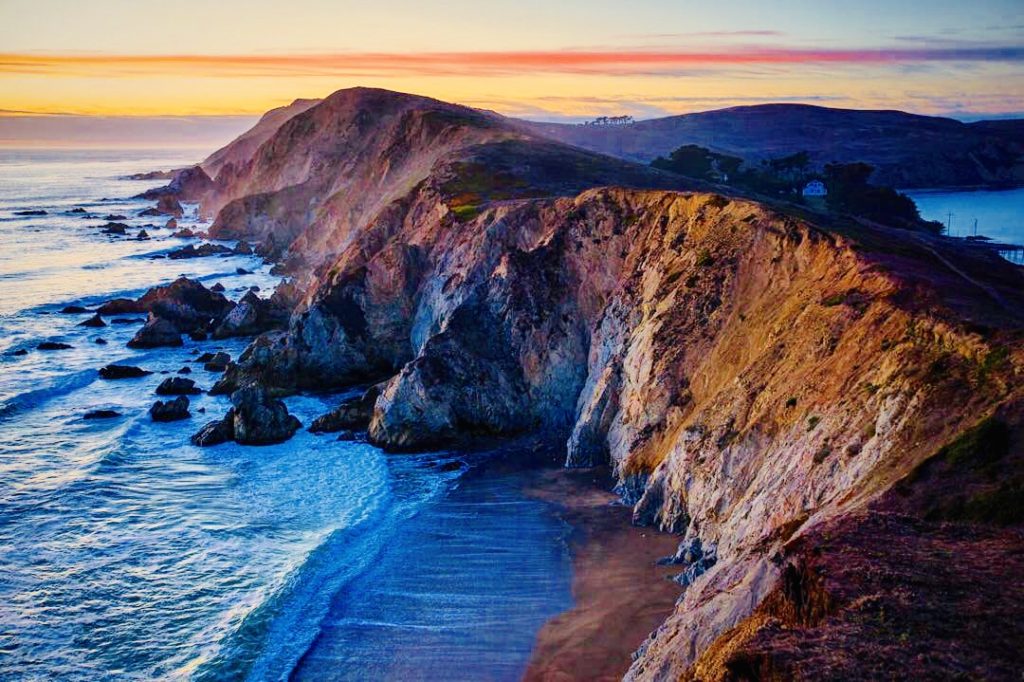
4. ELEPHANT SEALS & HISTORIC LIFEBOAT STATION NEAR CHIMNEY ROCK
When you leave the lighthouse, follow the one lane Chimney Rock Road to the right to the Chimney Rock parking area. Here you can check out the history of life-saving surf boats at the station (read about them here), observe the elephant seal rookery at Drake’s Beach, or hike three miles round trip to Chimney Rock for breathtaking cliffside views of the beach. Beginning in December, male elephant seals arrive and are soon followed by pregnant females in preparation for the birth of their pups. Point Reyes is one of only a handful of places on the Pacific Coast where they can be observed. Elephant seals were previously hunted to the point of near extinction for their oil-rich blubber. Fortunately, due to protection, their population has revived. The Point Reyes elephant seal population is now estimated to be between 1500 and 2000. Last year around Valentine’s Day, most of Drake’s Beach was closed due to being completely inundated with these honkers going bonkers! Be aware that no dogs are allowed on Drake’s Beach. It is a great place to stop and have a picnic, build sand castles, or collect driftwood and sea glass. You may want to bring binoculars for better views of the wildlife here. A visitor’s center and restrooms are available near the parking area. For more information see Drake’s Beach. If you enjoy history, by this time you may be wondering what is up with Sir Francis Drake Boulevard, Drake’s Beach, Drake’s Bay, etc. Apparently, Sir Francis Drake originally discovered Point Reyes in 1579, named it “New Albion”, and claimed it for England. In 2012, the area was designated a National Historic Landmark.
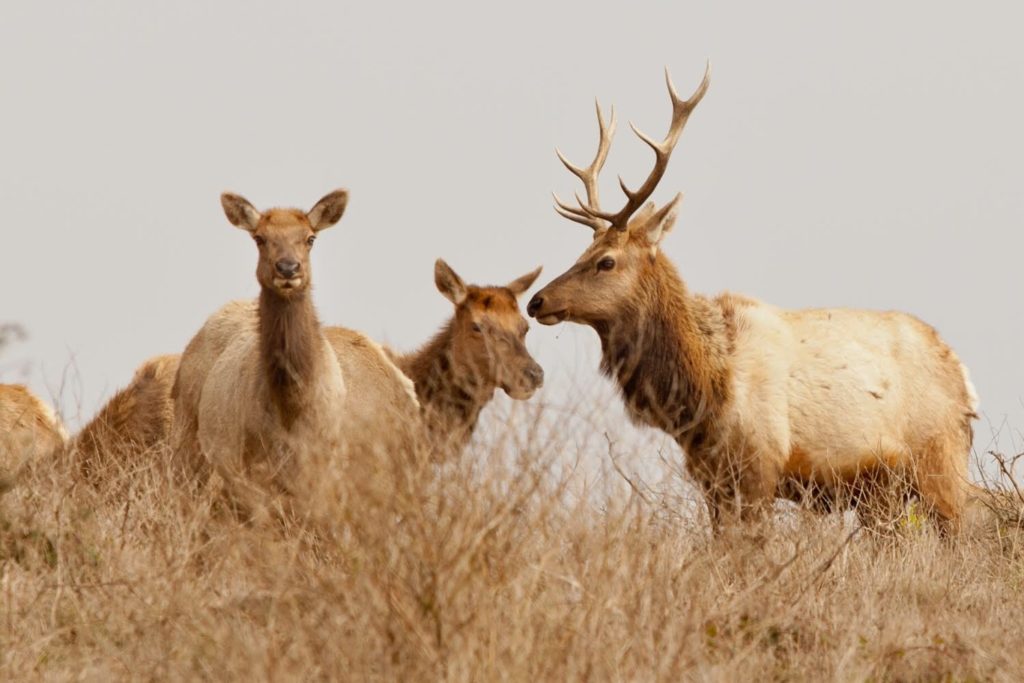
Photo courtesy of Jay Slupesky @jayslu 5. HIKING AT TULE ELK PRESERVE BY TOMALES BAY
Follow Sir Francis Drake Boulevard east for .3 miles until you come to Pierce Point Road, and follow this for 3.8 miles, staying left. The hike begins at the abandoned Pierce Point Ranch and ends on stately bluffs overlooking the ocean. The hike is 9.4 miles round trip. Stay on the well marked and maintained Tomales Point Trail to view herds of tule elk as they graze overlooking Tomales Bay. Tule elk are found only in California. They get their name from the tule, or sedge, in the freshwater marshes they feed upon. They almost became extinct in the late 1800s but due to conservation measures, there are approximately 5700 tule elk in the wild in California today per the California Department of Fish and Wildlife. Studies have shown that they play a critical role in maintaining native ecosystems. The males, with their antlers, remind me of Santa’s reindeer. Apparently, the best time to see the males bugling and fighting with each other over the females is in August through October. Bugling is a call the bulls make to attract the girls. Because they are wild animals, please observe them from a distance, stay on the trail, move and talk quietly, do not bring pets along, and do not feed the elk. The park service also asks that you do not remove any elk antlers as they provide an important source of calcium for other wildlife species. For more information, check out the California Department of Fish and Wildlife’s Tule Elk page. Restrooms are available at the beach parking lot on Pierce Point Road. Where: Pierce Point Road, Inverness, CA 94937 Phone: 415-464-5100
Helpful Hints:
- I highly recommend checking out the Point Reyes National Seashore Association, it has so much information it could literally be made into a book or even a documentary film. Seriously.
- If you want to check out the weather before you visit, see the Point Reyes Lighthouse Visitor Center Webcam
I hope you enjoyed this post and get a chance to visit Point Reyes. Tell me what you think! Thank you for visiting my blog! Wishing you peace, love, happiness, & beautiful vistas.
-
Skywalking Back in Time in Nicasio, California

Photo courtesy of Michael Ryan @michaelryanphoto. Ok, you can’t really skywalk in Nicasio, but I’ll get to that later. I first saw Nicasio on a trip back from Point Reyes to Monterey. I love old architecture and the fact that this tiny town was full of old Victorian buildings and cute little picket fences attracted me immediately. Nicasio has a population of fewer than 100 people per Wikipedia but the Nicasio website indicates they have “a few hundred families”. Let’s just say it’s very small. This quaint little town is located in a secluded valley eight miles southwest of Novato and is less than an hour drive north of San Francisco. It is the meeting place of four drainage areas for the Nicasio Creek and is the location of the man-made and quite lovely Nicasio Reservoir.

Nicasio is also home to a post office, general store, volunteer fire department, church, and what has to be the teeny tiniest historical society building ever. There is also a baseball field in the town square, a restaurant, and a Druid’s Hall. I am ashamed to say that at first, I imagined the Druid’s Hall was for people dressed like Gandalf from Lord of the Rings as a place to occasionally gain a reprieve from hours spent cavorting in copses of trees with their walking sticks and long white beards. I now realize they are a fraternal group similar to the Masons or the Shriners, the latter those guys who wear fezzes and speed around in itty bitty motorized cars in parades. They may look or seem odd but they are merely hanging out and doing wonderful philanthropic things to help other people.
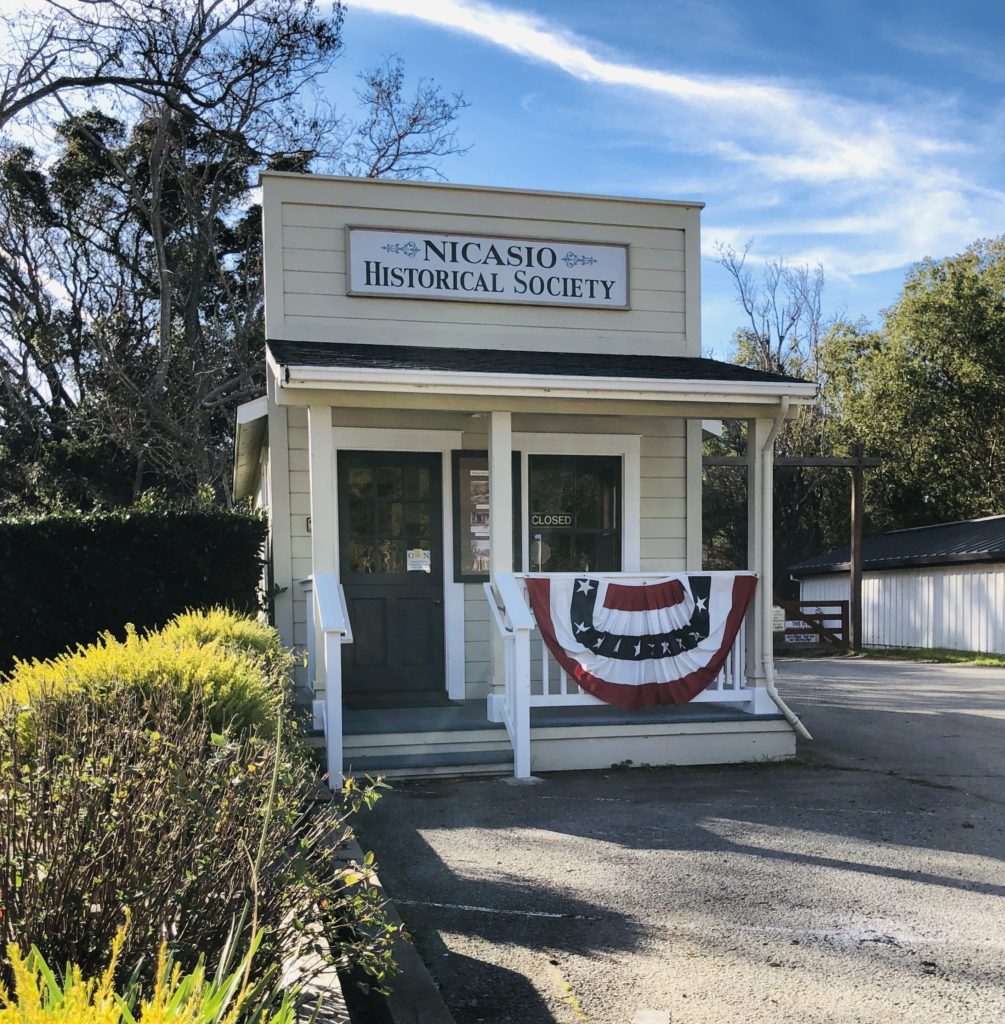
Most of the land around the town is filled with peacefully grazing cattle, rustic farms, and vineyards. After driving through town you enter a thick redwood forest to the east which is shadowy, elusive and possibly enchanted. (This is where I initially thought the Druids hung out). Ornithology buffs may be interested to know there is a bird named after the area. The Nicasio chickadee, which is a subspecies of the chestnut-backed chickadee, is a native here, so all you bird watchers should bring your binoculars if you want to catch a glimpse of these feathered friends.
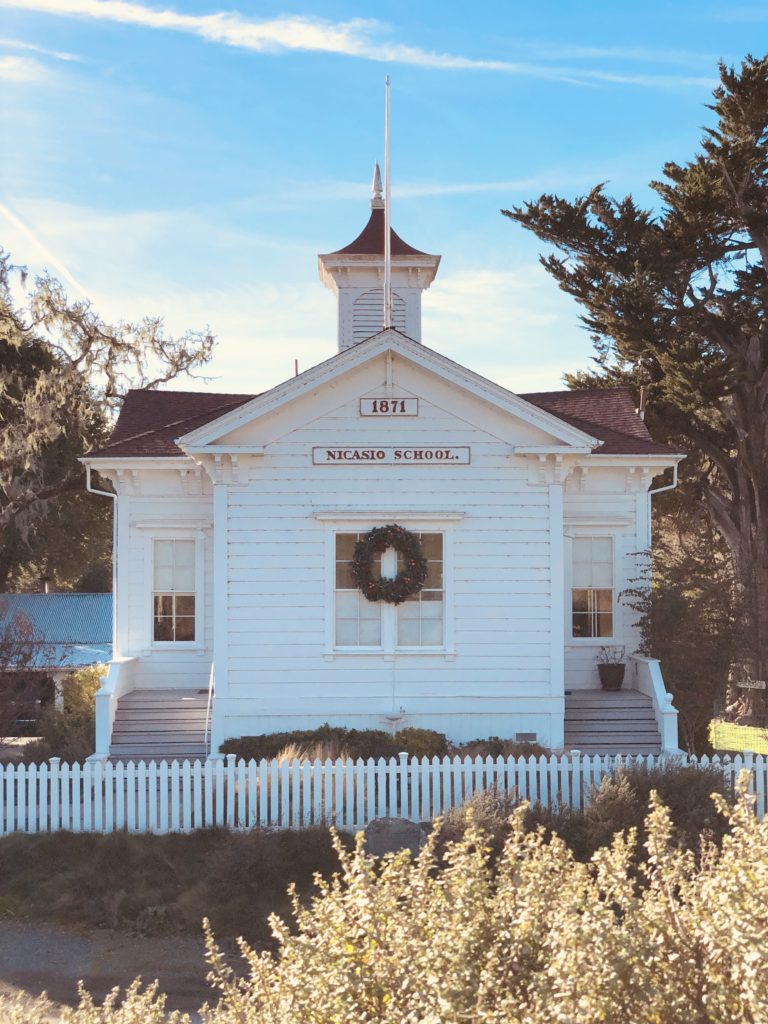
This Victorian school building featured prominently in a creepy horror movie filmed in Nicasio. It is dated 1871 and is a historical landmark. The town was also once home to a 22-room hotel which opened in 1867. Unfortunately, it burned down in 1940. A new restaurant/bar was built on the site and is now home to Rancho Nicasio, which features food, dancing and live music and is a venue for weddings as well as private parties and events. Rancho Nicasio is owned by Bob Brown, who was previously the manager for Pablo Cruise and Huey Lewis and the News. He is also part owner (with Boz Scaggs) of a San Francisco nightclub called Slim’s. His son, a graduate of the California Culinary Academy heads the kitchen. I am hoping to check this place out on my next visit to Nicasio, it sounds amazing!
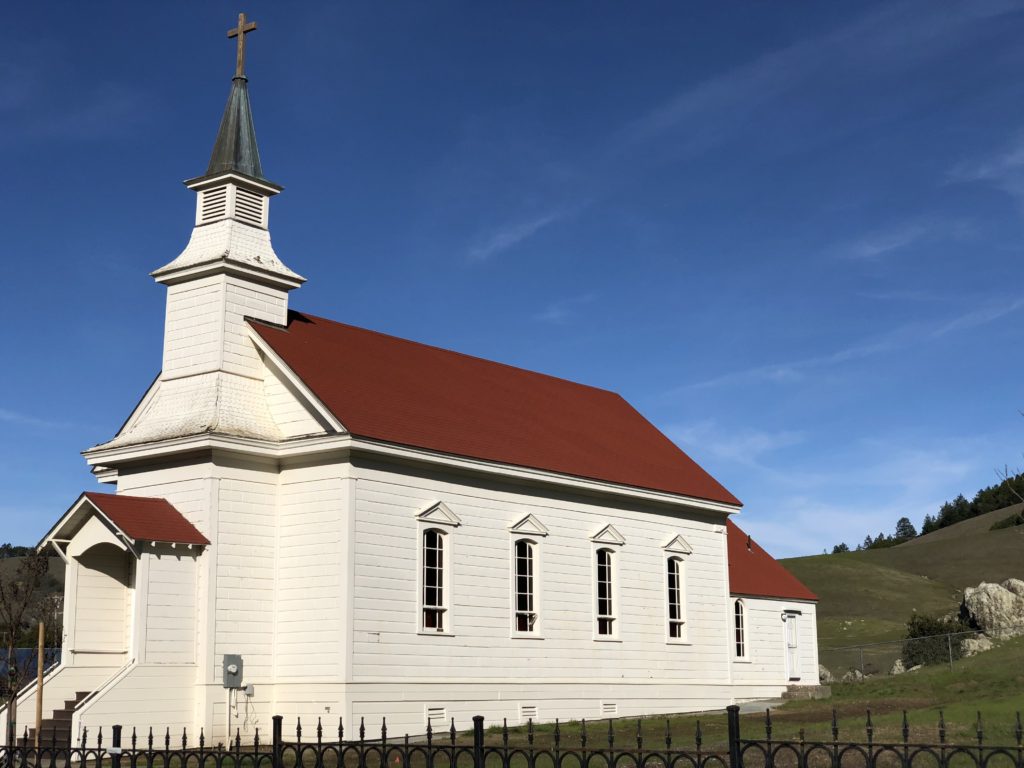
The very picturesque St. Mary’s Catholic Church was built in 1867 from local redwood. Nicasio has its own website and it is described as “The Marin County town that time forgot”. Time may have forgotten it but it has certainly been the source for modern inspiration. This little town is actually the headquarters for George Lucas’s Skywalker Ranch. What? Seriously? Yes, George Lucas can skywalk away here on his ranch and relive his Star Wars and Indiana Jones glory while we mortals are doomed to pathetically shamble about on the ground. That’s life. By the way, Skywalker Ranch is closed to the public, and there are tons of armed security guards patrolling the grounds. I am sorry to dash your dreams of convincing George to let you skywalk with him. Yet, before you are completely crestfallen, let me tell you that George Lucas has his own winery here! Yes, you can drown your sorrows in a big glass of chardonnay or pinot noir from Skywalker Vineyards. Unfortunately, there is no public tasting room at Skywalker Vineyards, they have a private tasting room by invitation only. However, you can order Skywalker wines online at their website: Skywalker Vineyards. The SV website states that Lucas was inspired by his friend Francis Ford Coppola to create the vineyard and winery. Coppola and Lucas have known each other for decades and worked together on the famous 1973 film American Graffiti which Lucas co-wrote and directed and Coppola produced.
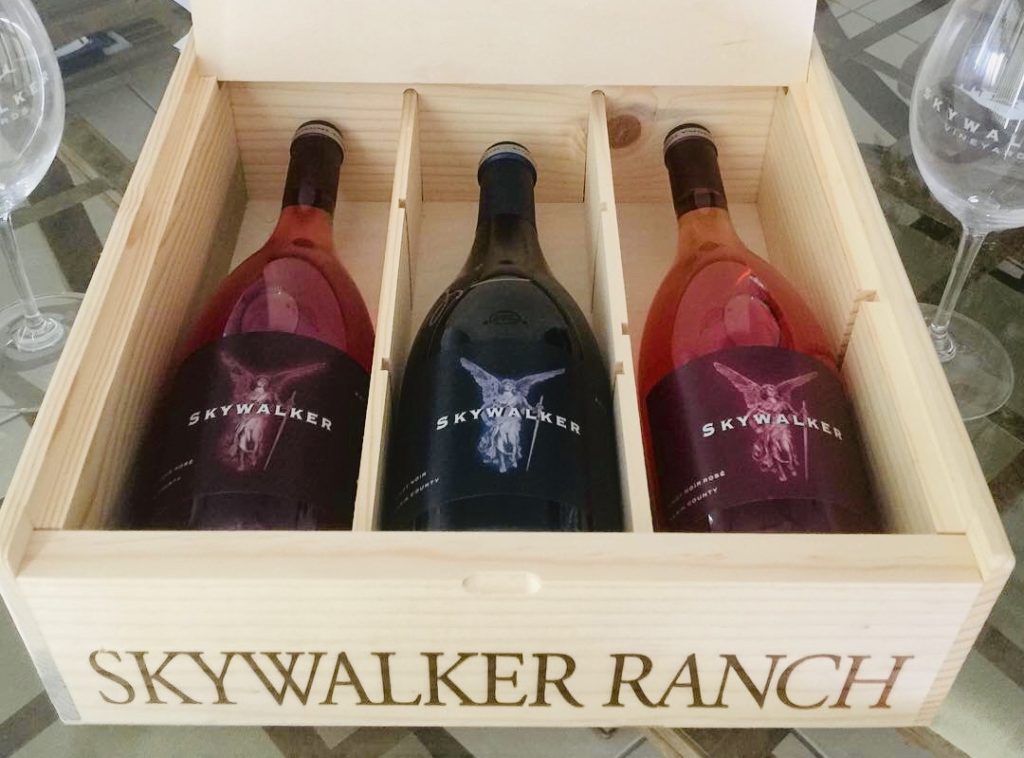
Nicasio also served as a film location for a few movies including The People, which stars William Shatner in his hipster years, Shoot the Moon, which features Albert Finney and Diane Keaton (and garnered them both Golden Globe nominations), and Village of the Damned. The latter, shot in 1995, features the Nicasio School as well as multiple homes and landmarks in the area. Village of the Damned is an American remake of an old 1960 British horror film. It stars Christopher Reeve in his last film role before becoming paralyzed, as well as Kirstie Alley and Mark Hamill (aka Luke Skywalker). Before you rush to see this movie, be aware that in addition to being a pretty sorry failure at the box office, it was nominated at the 16th Golden Raspberry Awards for Worst Prequel, Remake, Rip-off or Sequel.
Pearl Jam fans may be interested to know that their 1993 song “Daughter” was recorded here. Apparently, it is about a girl with dyslexia. I love this song, especially the part where they yell “She will rise above!”. Just gives me goosebumps.
So now, if you drive through a little town called Nicasio, you will know that there is much more to this pastoral, quiet village than meets the eye. You may want to crank up Pearl Jam and pay homage to George Lucas as you pass through by whispering the following words, “I’m one with the Force. The Force is with me”. Perhaps, one day, he will open Skywalker Ranch or Vineyards to us so we can live our skywalking dreams. Until then, thank you for visiting my blog! Wishing you peace, love, happiness & beautiful vistas.